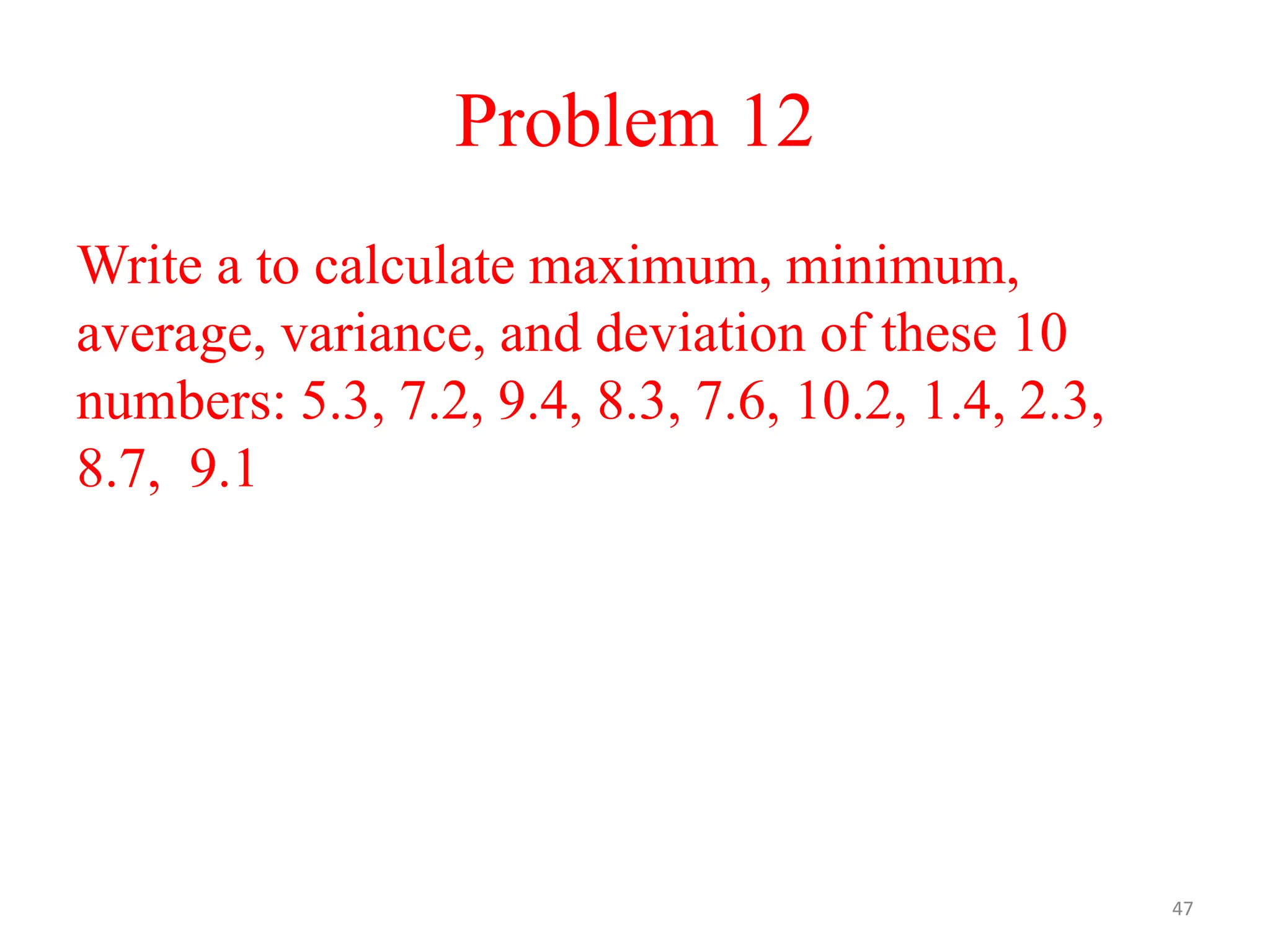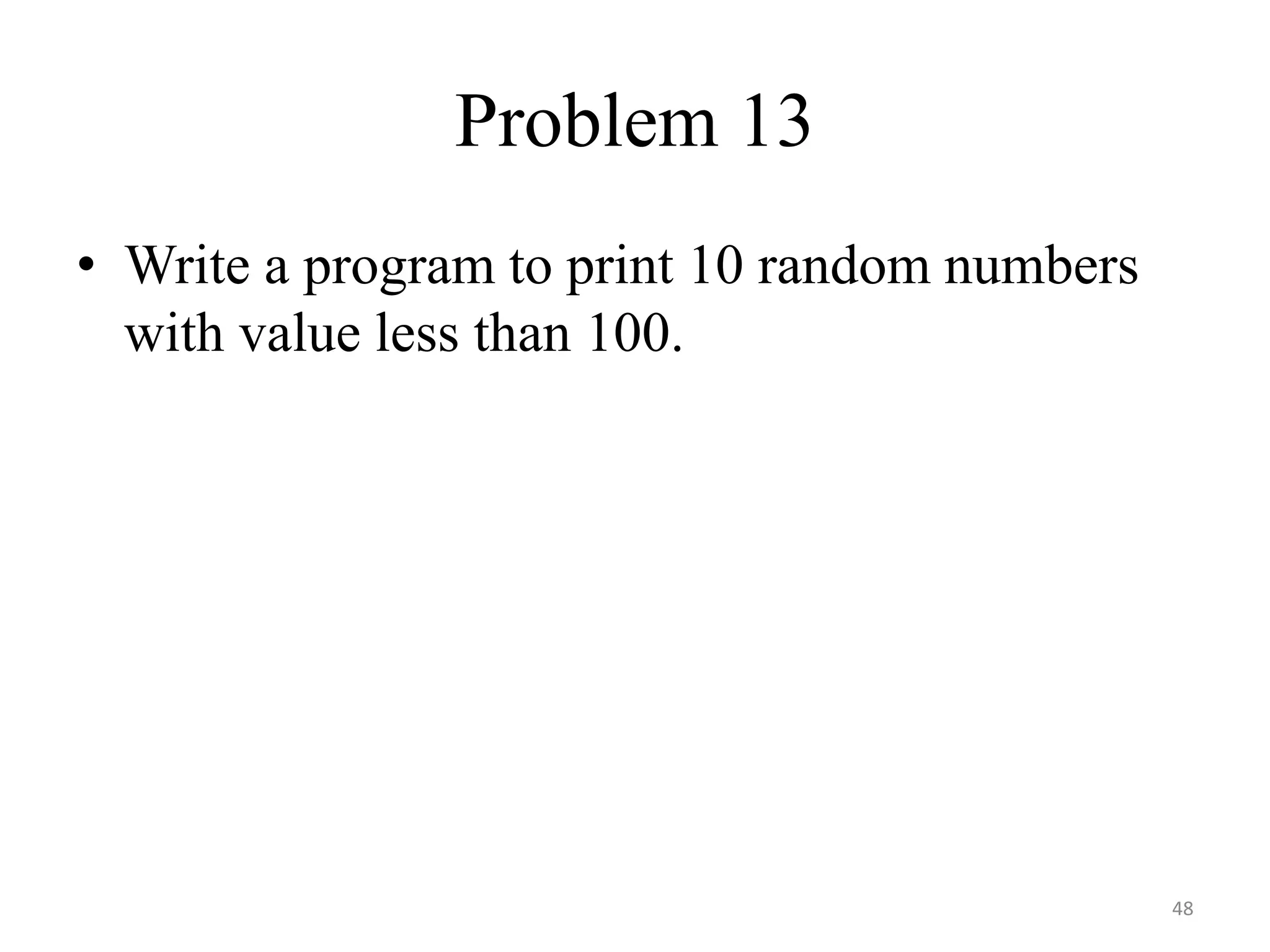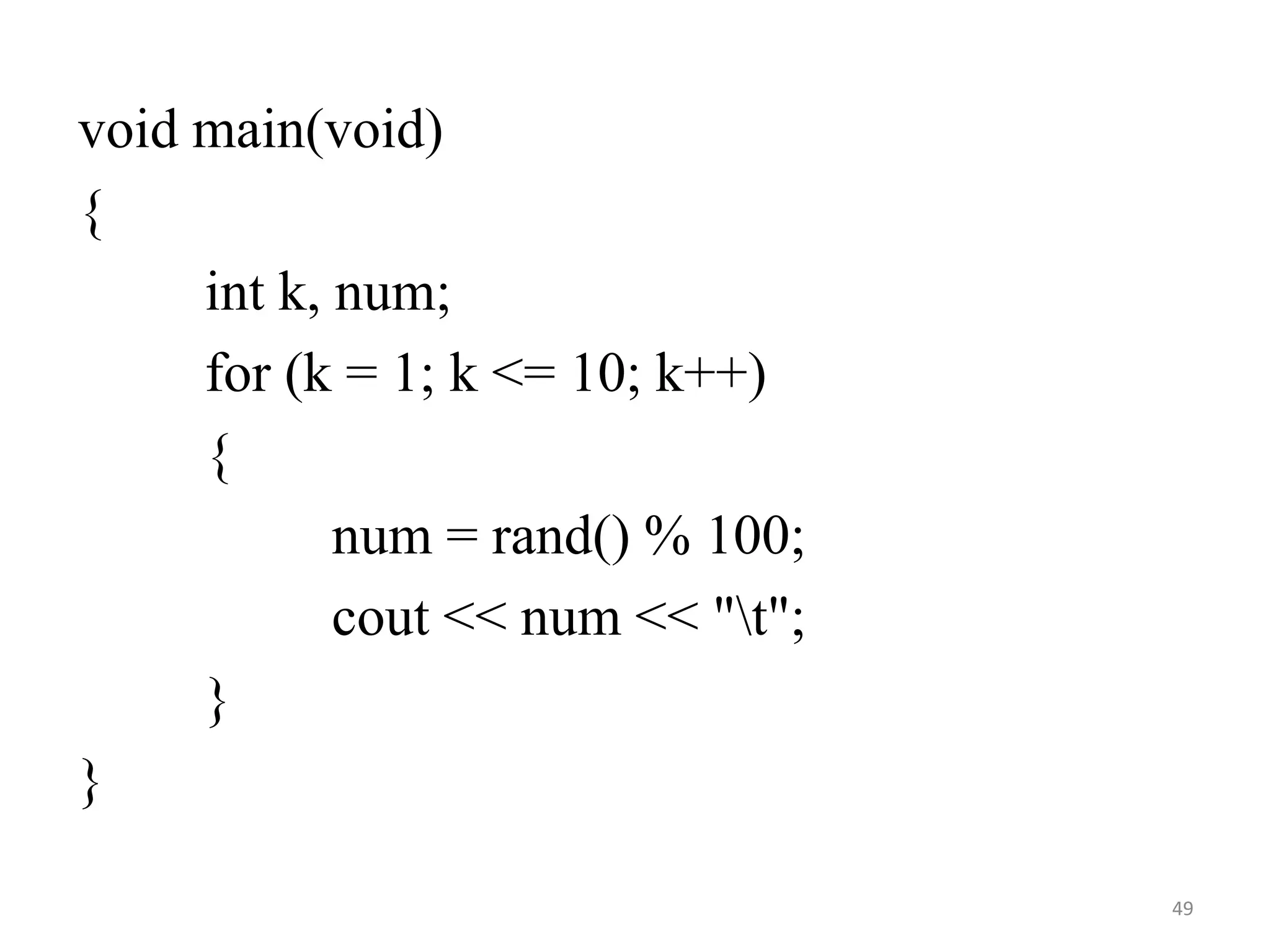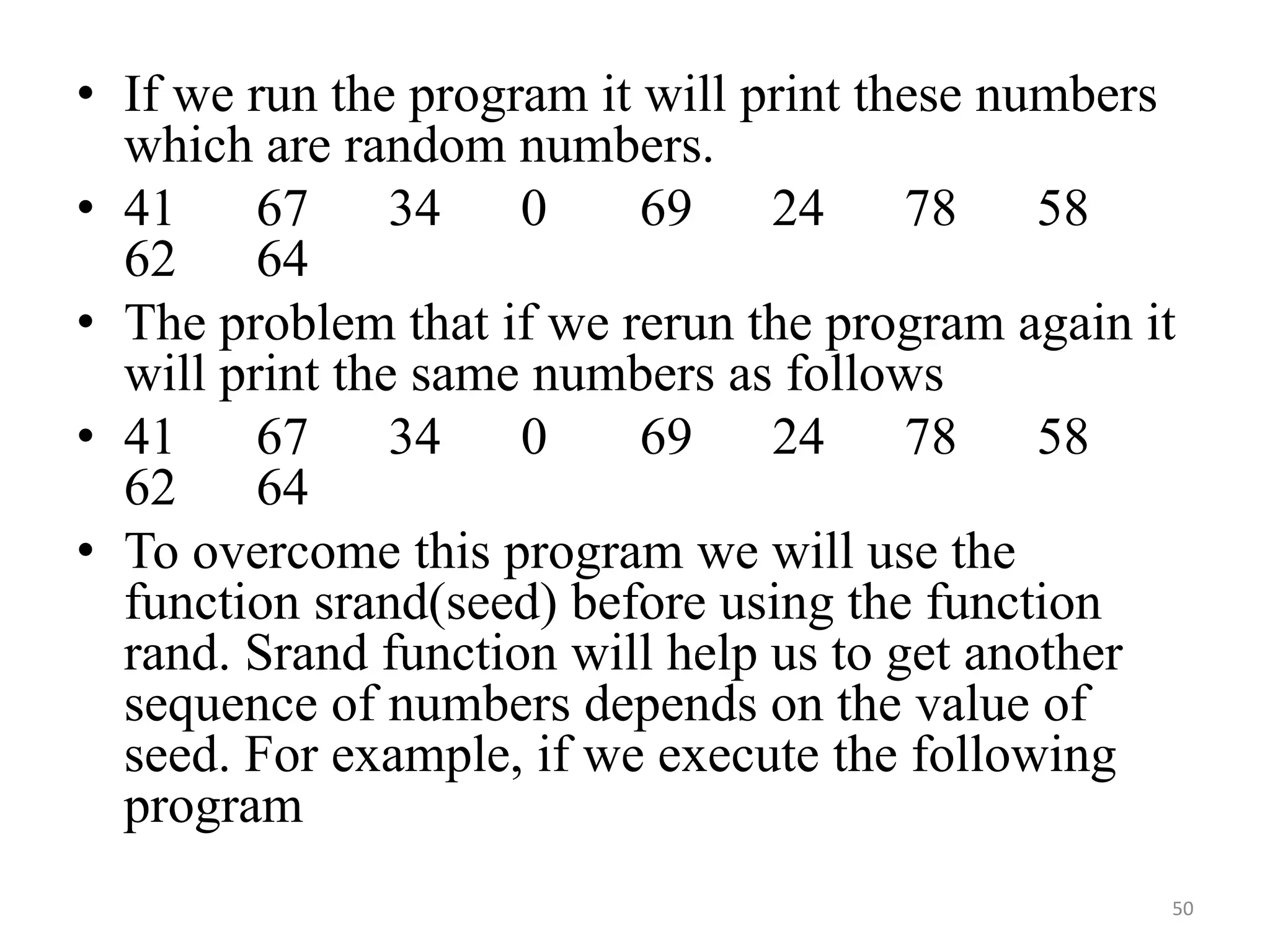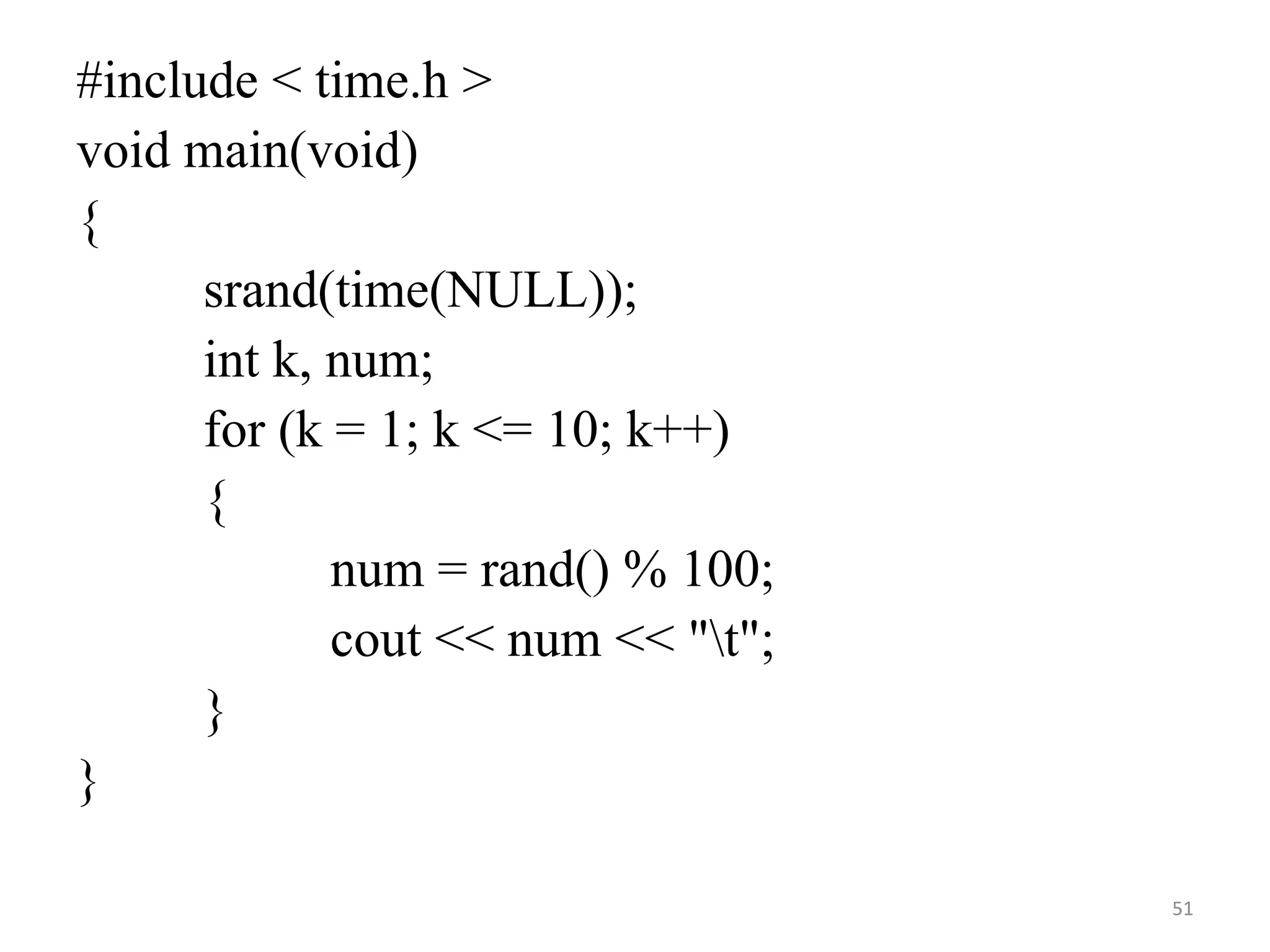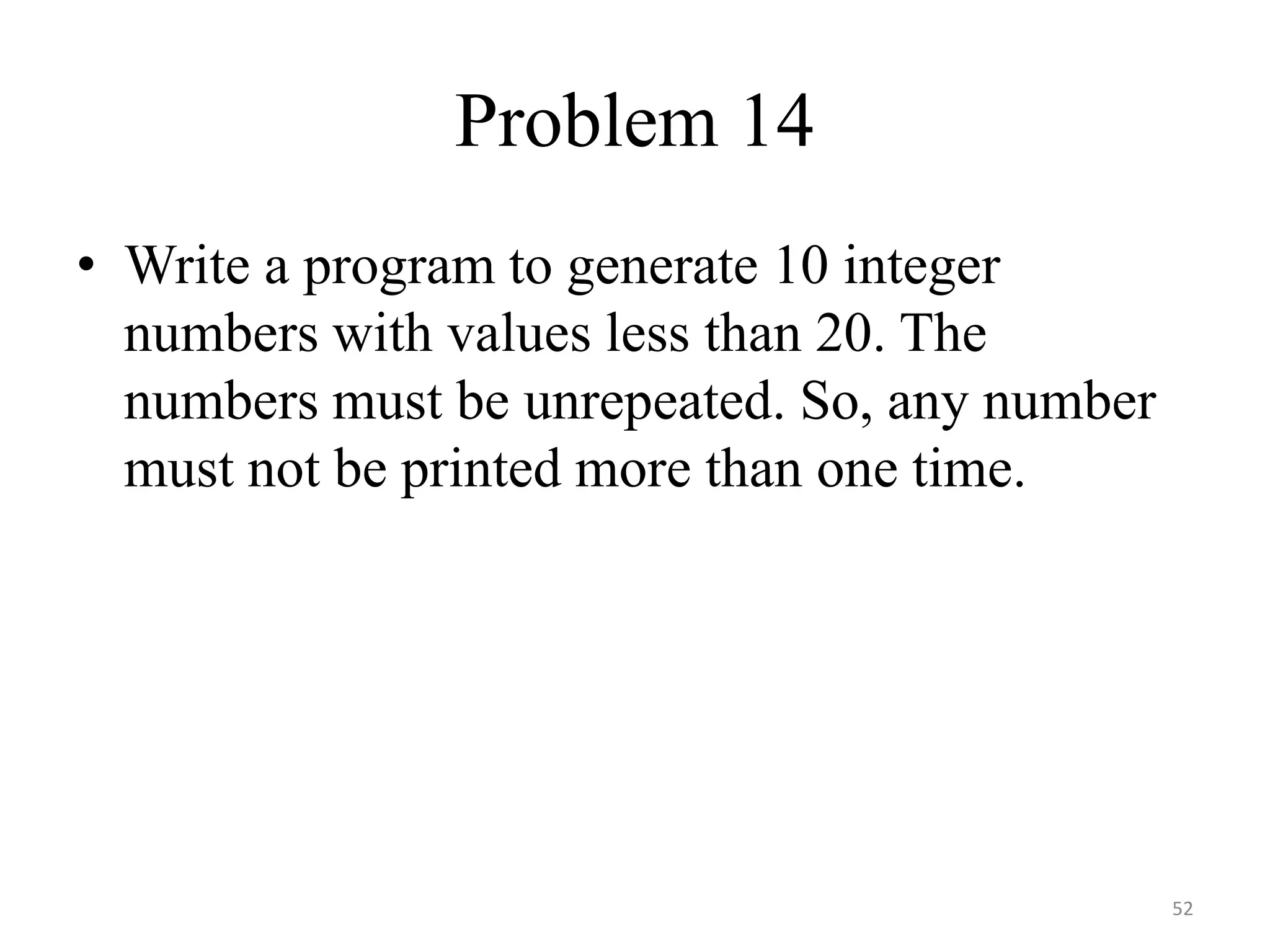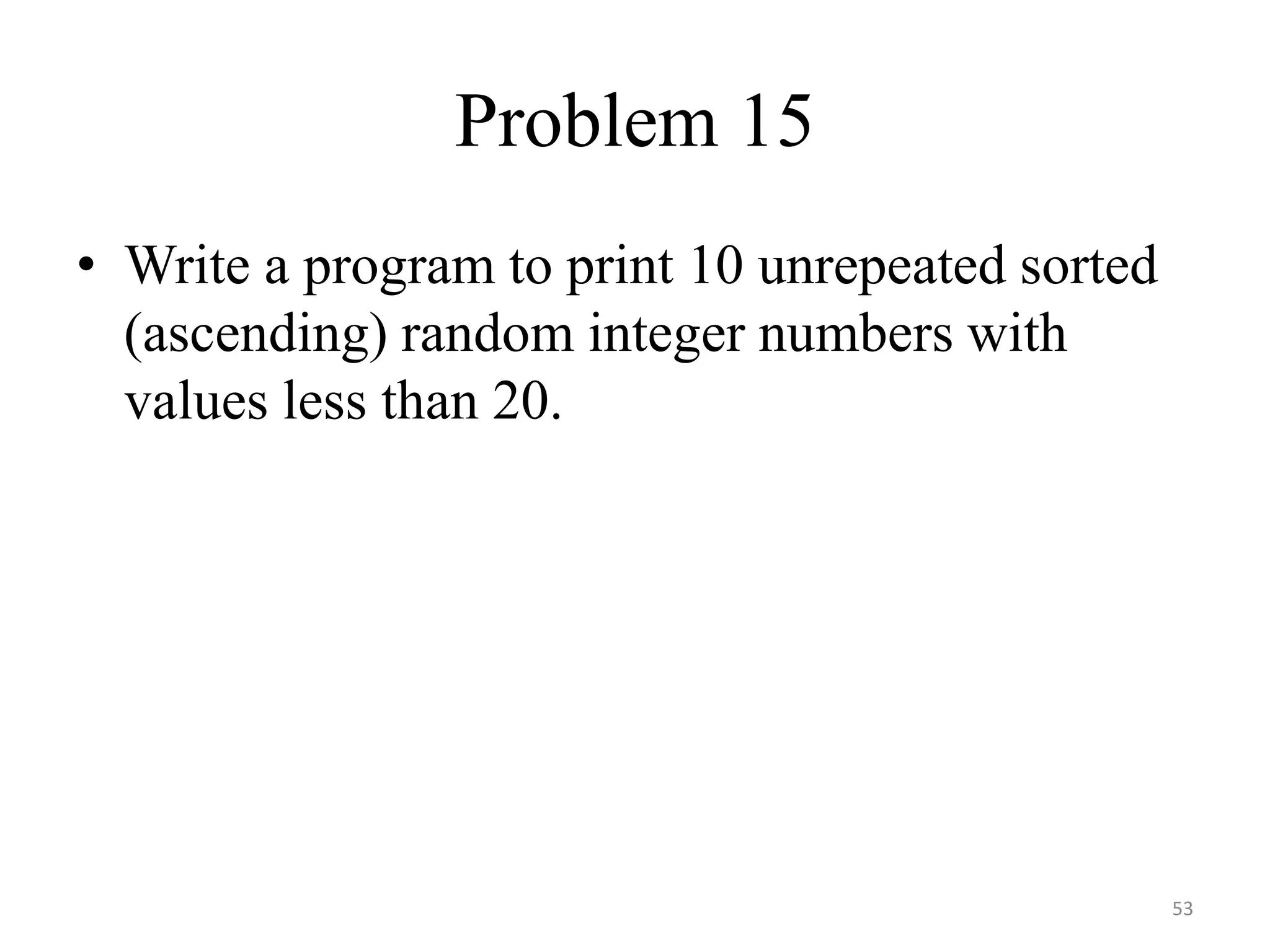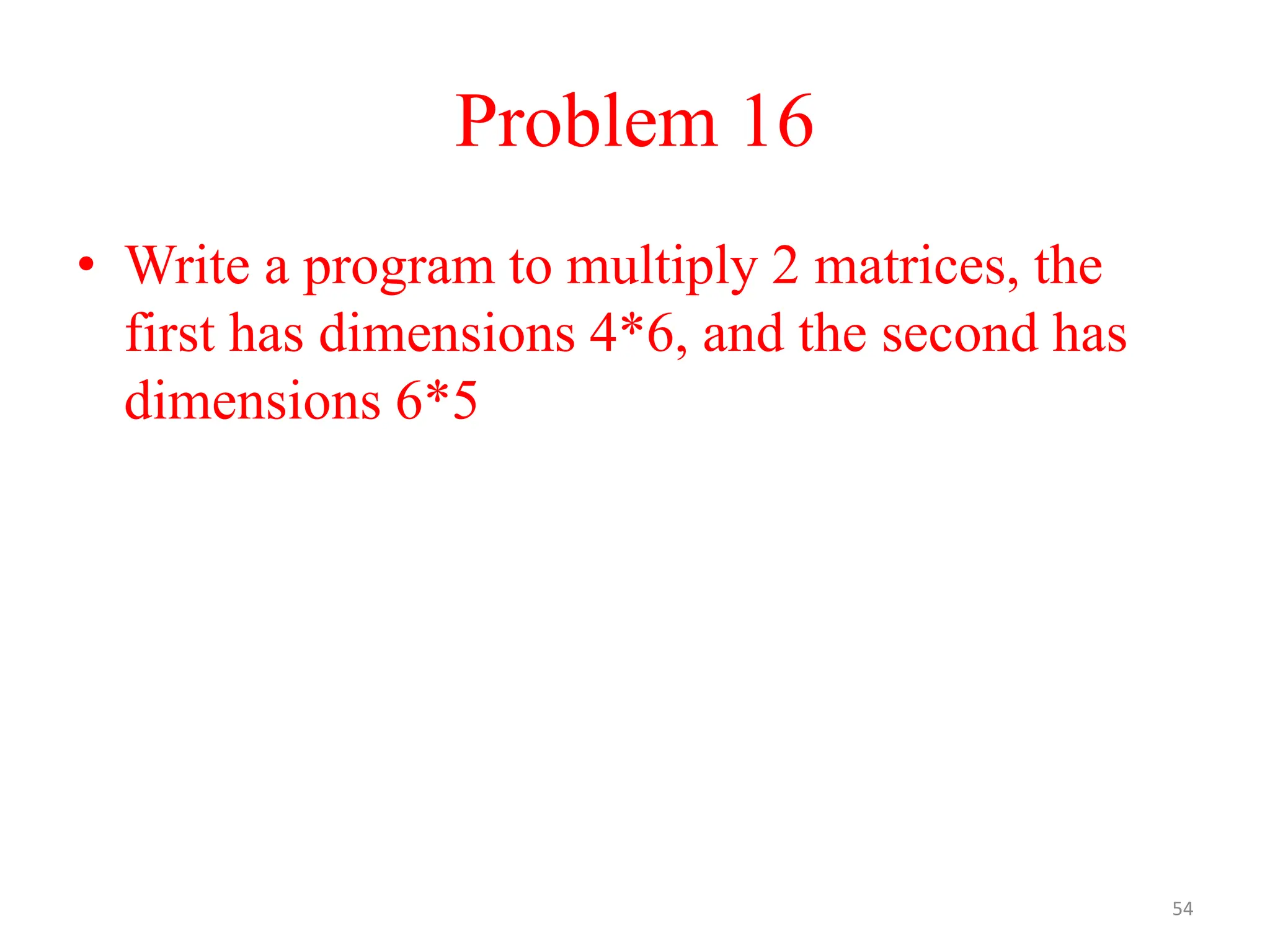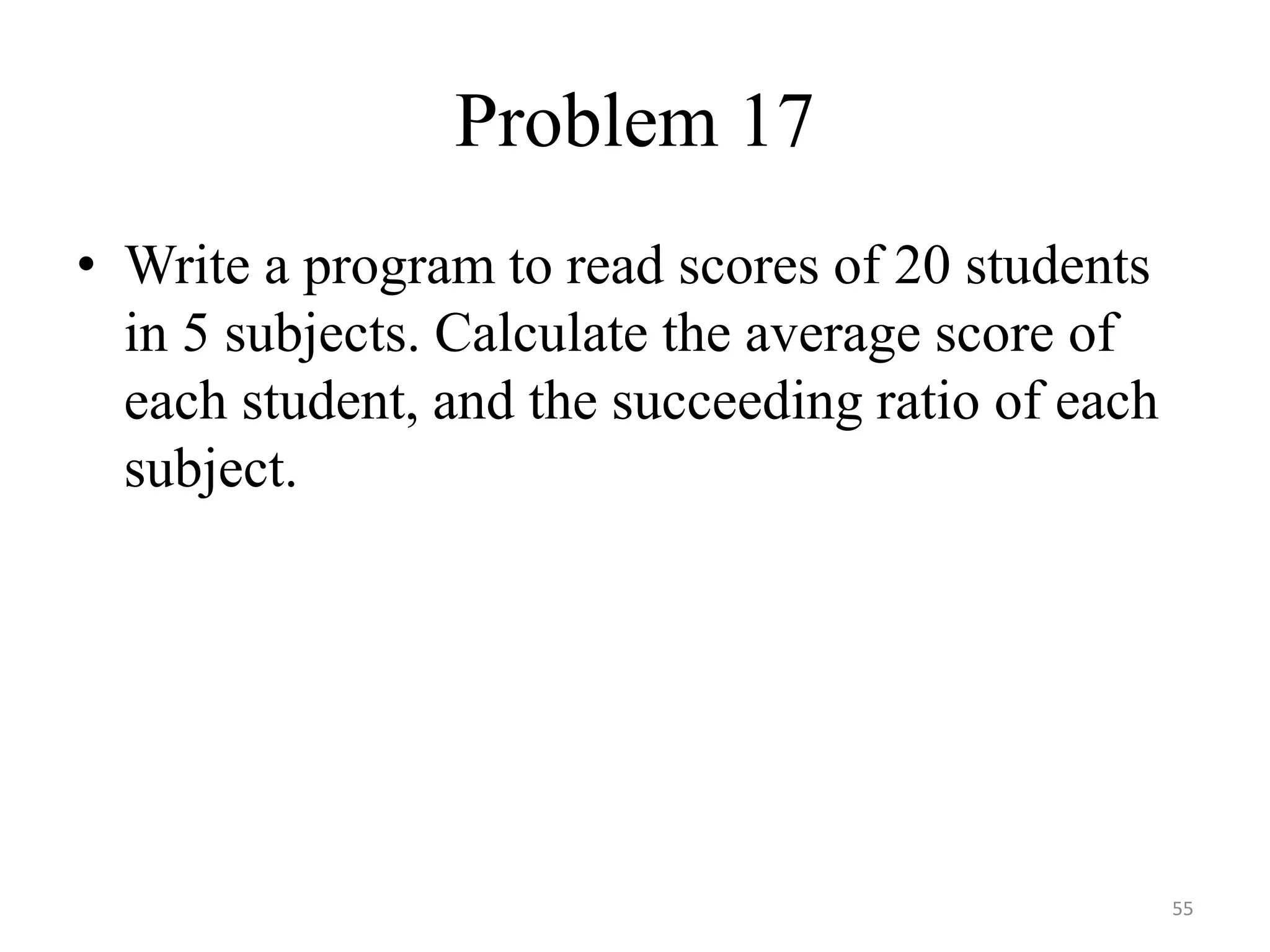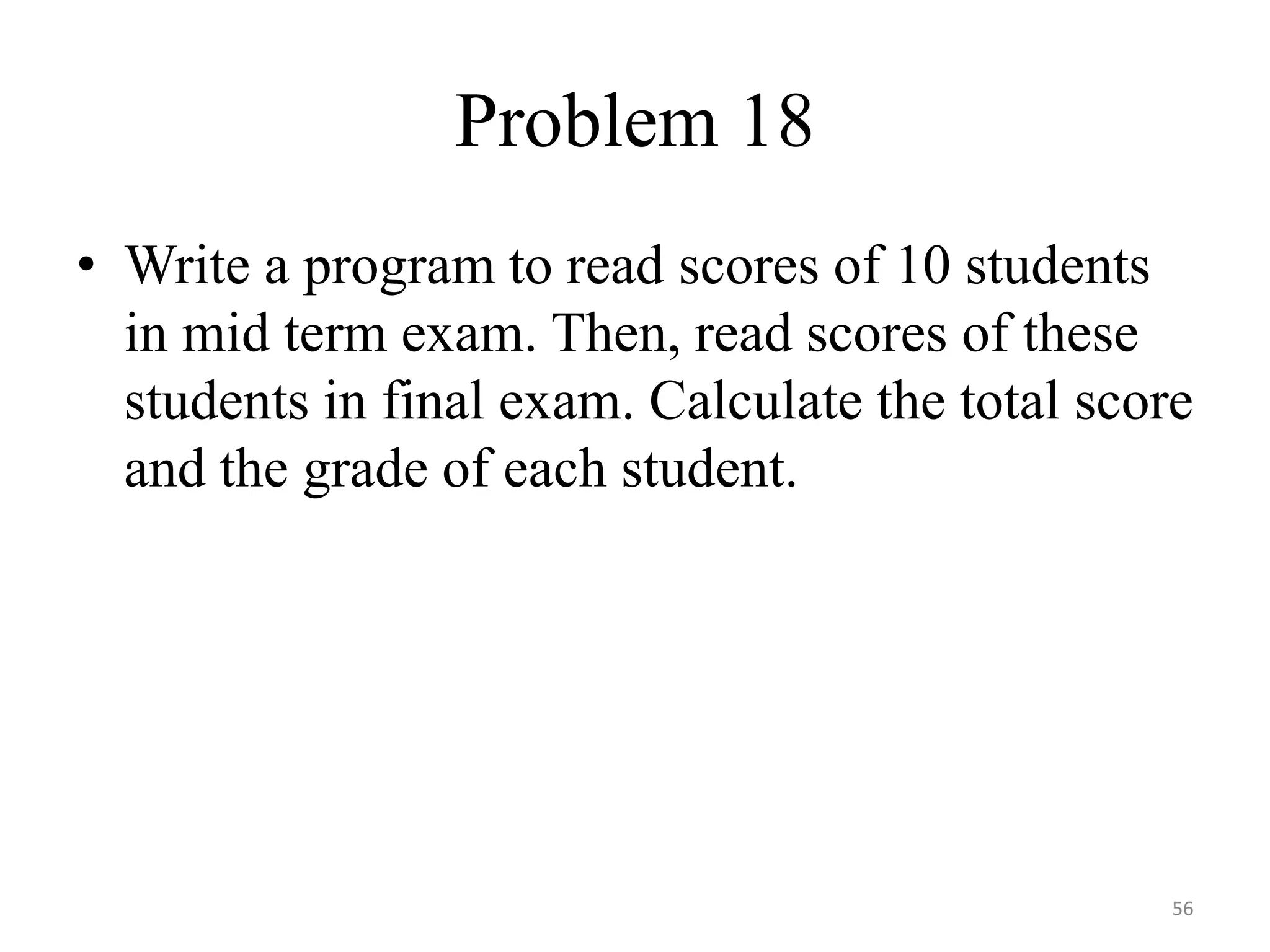This document covers the concept of arrays in C++, detailing their definition, declaration, initialization, access methods, and various operations such as searching, summing, and sorting elements. It explains the use of single and multidimensional arrays, including practical examples involving data manipulation tasks like finding minimum values and calculating averages. Additionally, it includes several programming problems that illustrate array operations and challenge the reader to apply the concepts learned.
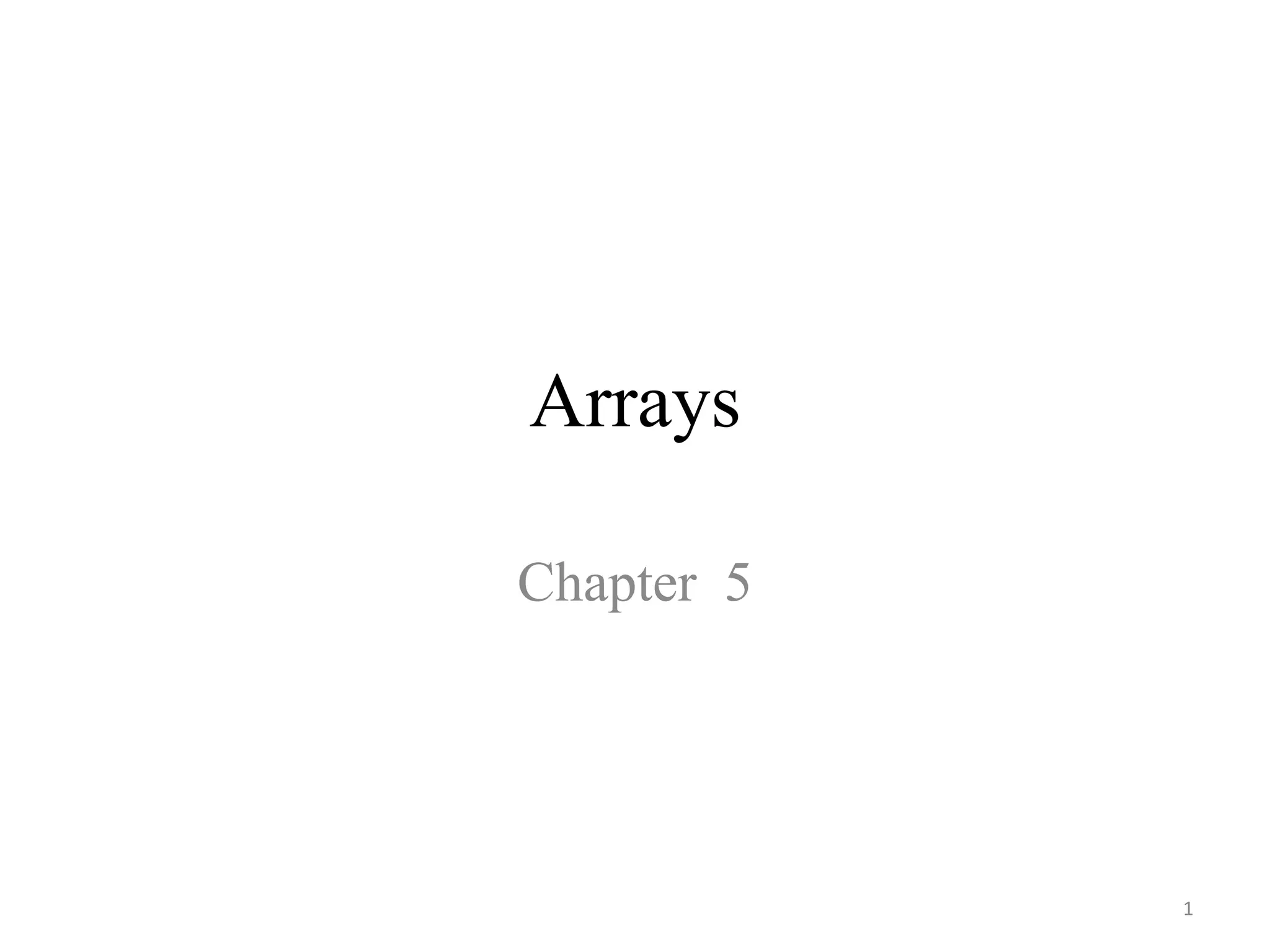
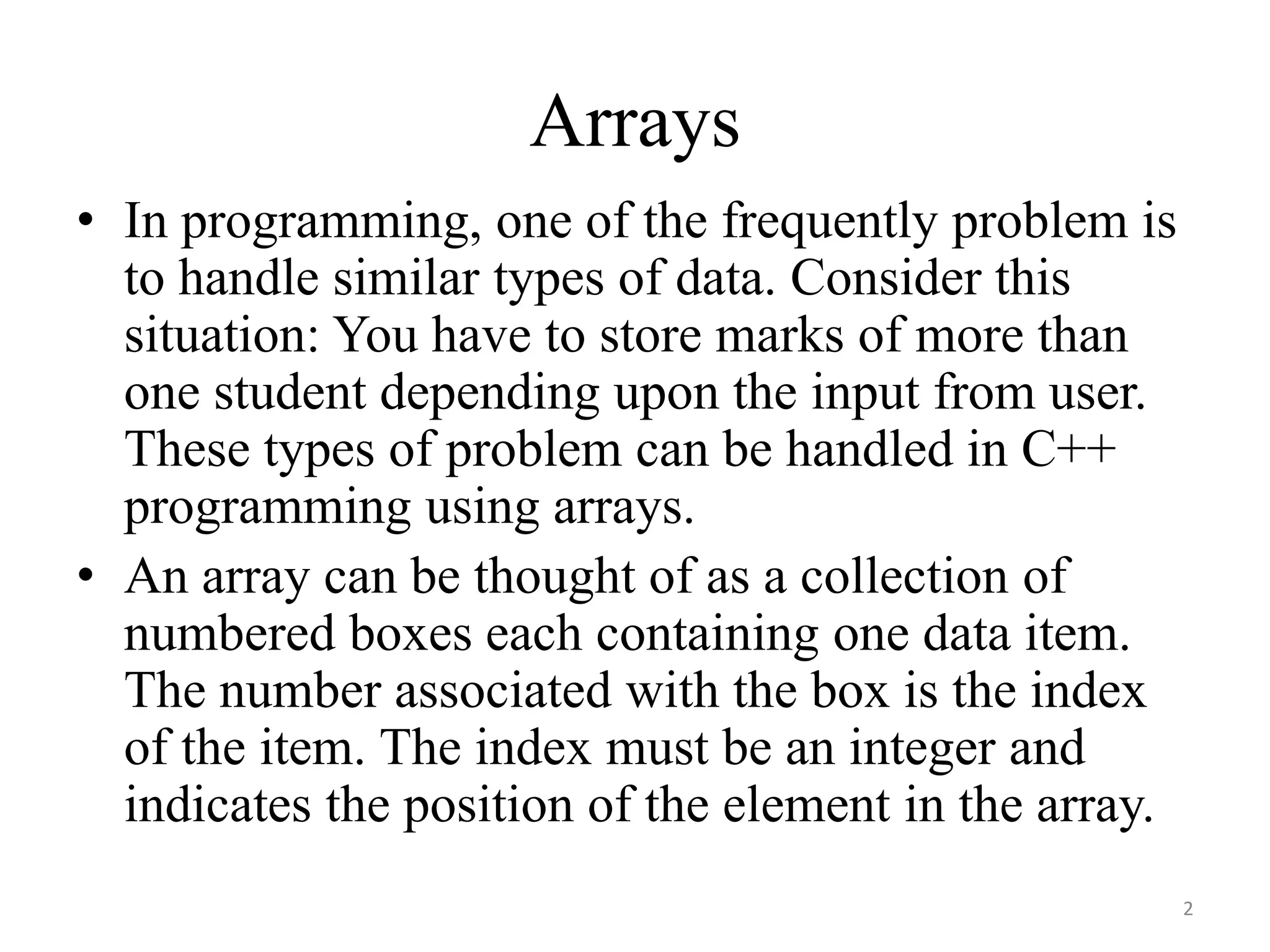
![• Instead of declaring individual variables, such
as number0, number1, ..., and number99, you
declare one array variable such as numbers and
use numbers[0], numbers[1], and ...,
numbers[99] to represent individual variables.
A specific element in an array is accessed by
an index.
• Notice that the first element of an array called
foo is foo[0] not foo[1]. These elements are
numbered from 0. In C++, the first element in
an array is always numbered with a zero (not a
one), no matter its length.
3](https://image.slidesharecdn.com/05arrays-241020111439-f53002de/75/05_Arrays-C-plus-Programming-language22-pdf-3-2048.jpg)
![Declaring Arrays
• Like a regular variable, an array must be declared
before being used. To declare an array in C++, the
programmer specifies the type of the elements
and the number of elements required by an array.
For examples:
• int myarray[10];
• The above statement declares an array called
myarray. This array contains 10 elements of type
integer. The first element will be myarray[0] and
the last element will be myarray[9].
4](https://image.slidesharecdn.com/05arrays-241020111439-f53002de/75/05_Arrays-C-plus-Programming-language22-pdf-4-2048.jpg)
![• When declaring an array, we saw that you must
specify the number of items that the array is made
of. An alternative is to define a constant prior to
declaring the array and use that constant to hold
the dimension of the array. Here is an example:
• const int numberOfItems = 5;
• double distance[numberOfItems] ;
• Note that numberOfItems must be a const. So the
following code will give an error.
• int ItemsNumber = 5;
• double distance[ItemsNumber] ;
• // Wrong, ItemsNumber must be constant
5](https://image.slidesharecdn.com/05arrays-241020111439-f53002de/75/05_Arrays-C-plus-Programming-language22-pdf-5-2048.jpg)
![Initializing arrays
• Here ia an examples of declaring and
initializing arrays:
• int arr[ 6 ] = { 7 , 2 , 4 , 9 , 10 , 3};
• int arr[ ] = { 7 , 2 , 4 , 9 , 10 , 3};
• int arr[ 10 ] = { 7 , 2 , 4 , 9 , 10 , 3};
• int arr[ 6 ] = { };
6](https://image.slidesharecdn.com/05arrays-241020111439-f53002de/75/05_Arrays-C-plus-Programming-language22-pdf-6-2048.jpg)
![Accessing the values of an array
• The following statement stores the value 75 in the third
element of foo:
• foo[2] = 75;
• The following copies the value of the third element
of foo to a variable called x:
• x = foo[2];
• Notice that the third element of foo is specified foo[2],
since the first one is foo[0], the second one is foo[1],
and therefore, the third one is foo[2].
7](https://image.slidesharecdn.com/05arrays-241020111439-f53002de/75/05_Arrays-C-plus-Programming-language22-pdf-7-2048.jpg)
![Important
• C++ does not check that the subscript that is
used to reference an array element actually lies
in the subscript range of the array.
• int arr[10];
• arr[17] = 22;
• This would lead to the program being
terminated by the operating system.
Alternatively it might assign a value to that
location, changing the value of the variable in
your program which is actually associated with
that memory location.
8](https://image.slidesharecdn.com/05arrays-241020111439-f53002de/75/05_Arrays-C-plus-Programming-language22-pdf-8-2048.jpg)
![The size of an array
• Imagine you declare an array as follows:
• int arr[] = {18, 42, 25, 12, 34, 15, 63, 72, 92,
26, 26, 12, 127, 4762, 823, 236, 84, 5};
• Instead of counting the number of members of
this array, you can use the sizeof operator as
follows:
• int NumberOfItemsOfTheArray =
sizeof(arr)/sizeof(int);
9](https://image.slidesharecdn.com/05arrays-241020111439-f53002de/75/05_Arrays-C-plus-Programming-language22-pdf-9-2048.jpg)
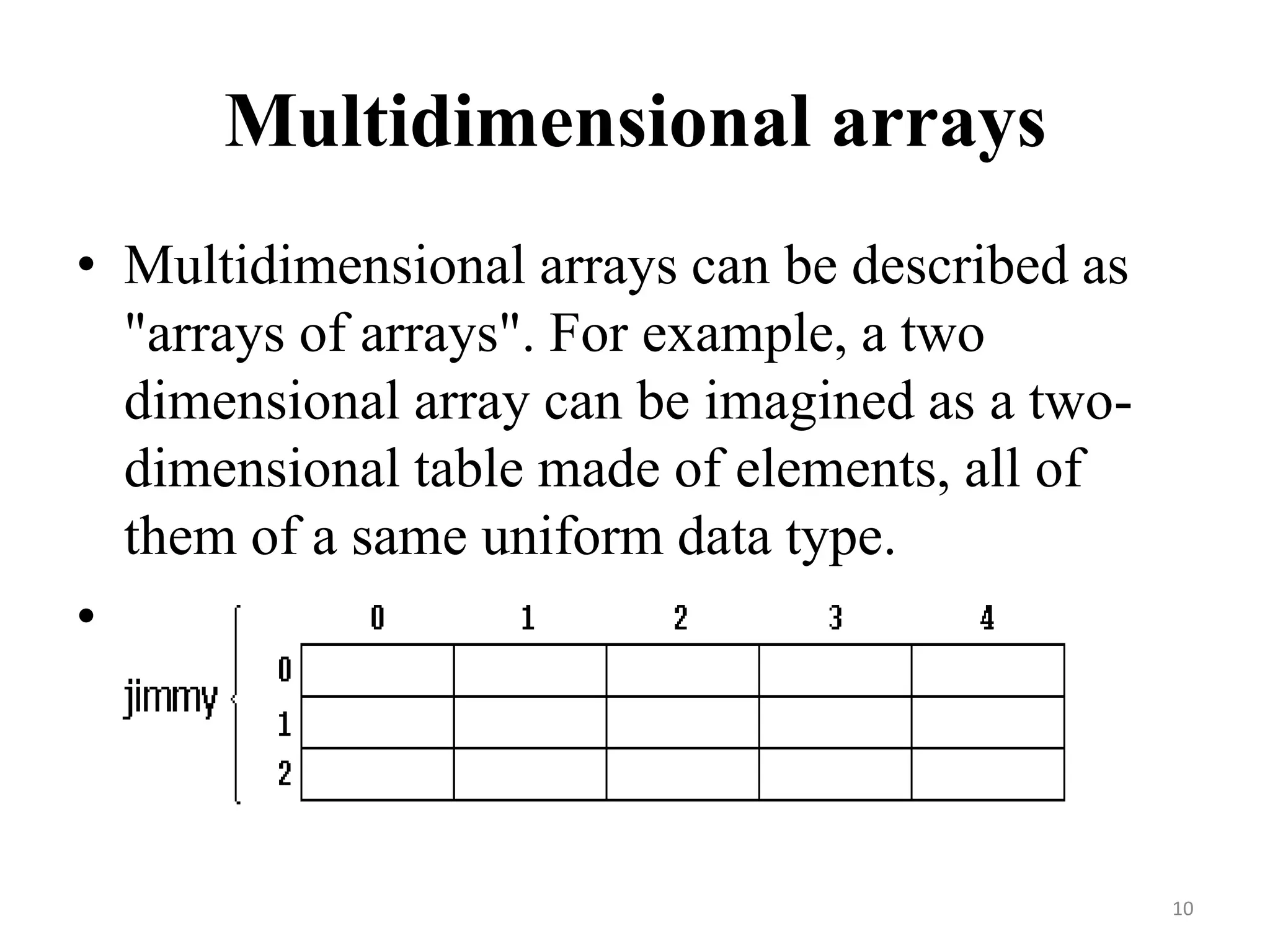
![• The C++ syntax for this two dimensional array
is:
• int jimmy[3][5];
• the way to reference the second element
vertically and fourth horizontally in an
expression would be:
• jimmy[1][3] = 88;
• Multidimensional arrays are not limited to two
dimensions). They can contain as many
dimensions as needed.
11](https://image.slidesharecdn.com/05arrays-241020111439-f53002de/75/05_Arrays-C-plus-Programming-language22-pdf-11-2048.jpg)
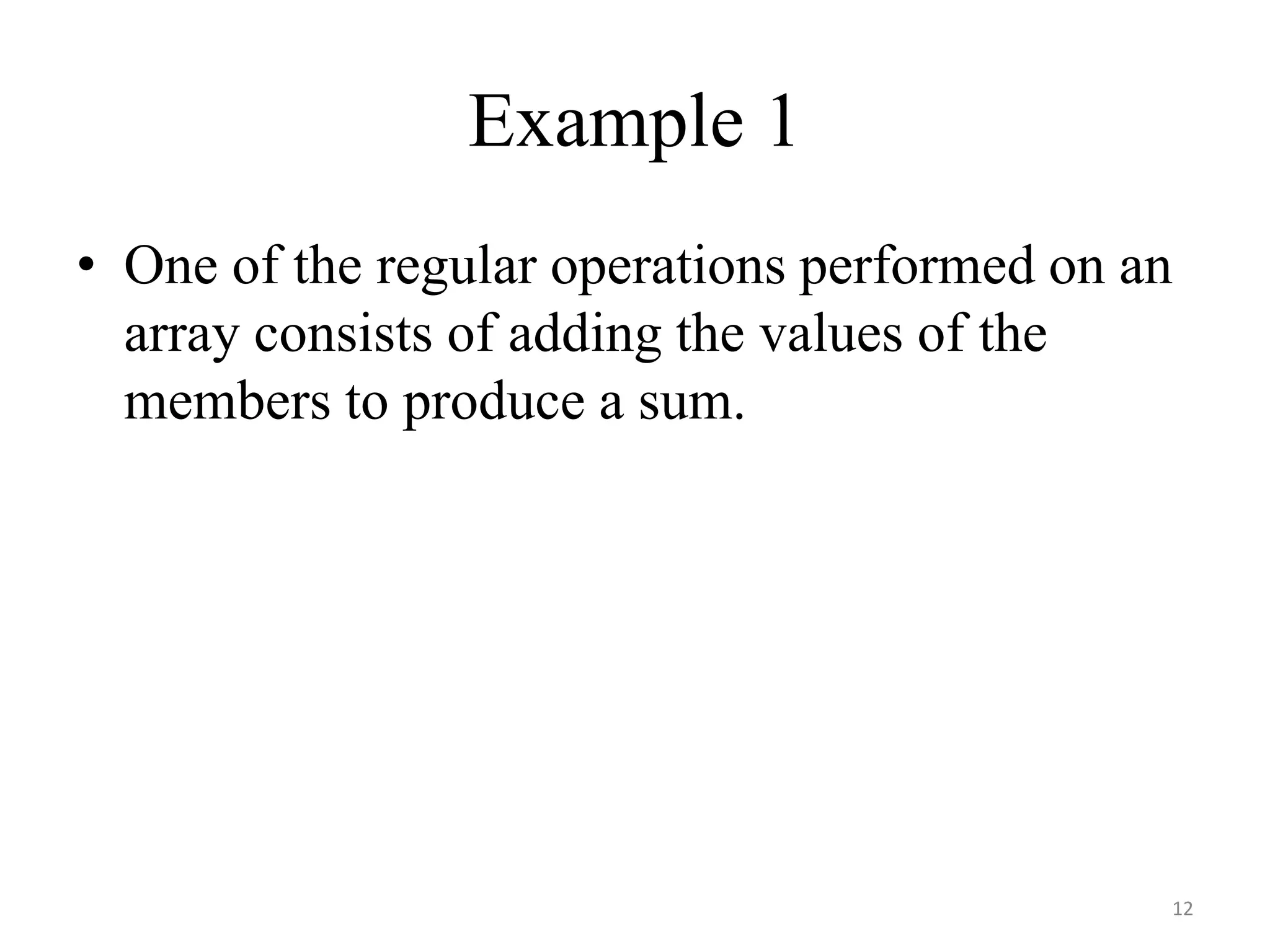
![int main()
{
int number[10] = {20,14,6,28,11,13,15,17,4,25};
int sum = 0;
for( int i = 0; i < 10; i++ )
{
sum += number[i];
}
cout << “Sum of numbers is " << sum << "n";
return 0;
}
13](https://image.slidesharecdn.com/05arrays-241020111439-f53002de/75/05_Arrays-C-plus-Programming-language22-pdf-13-2048.jpg)
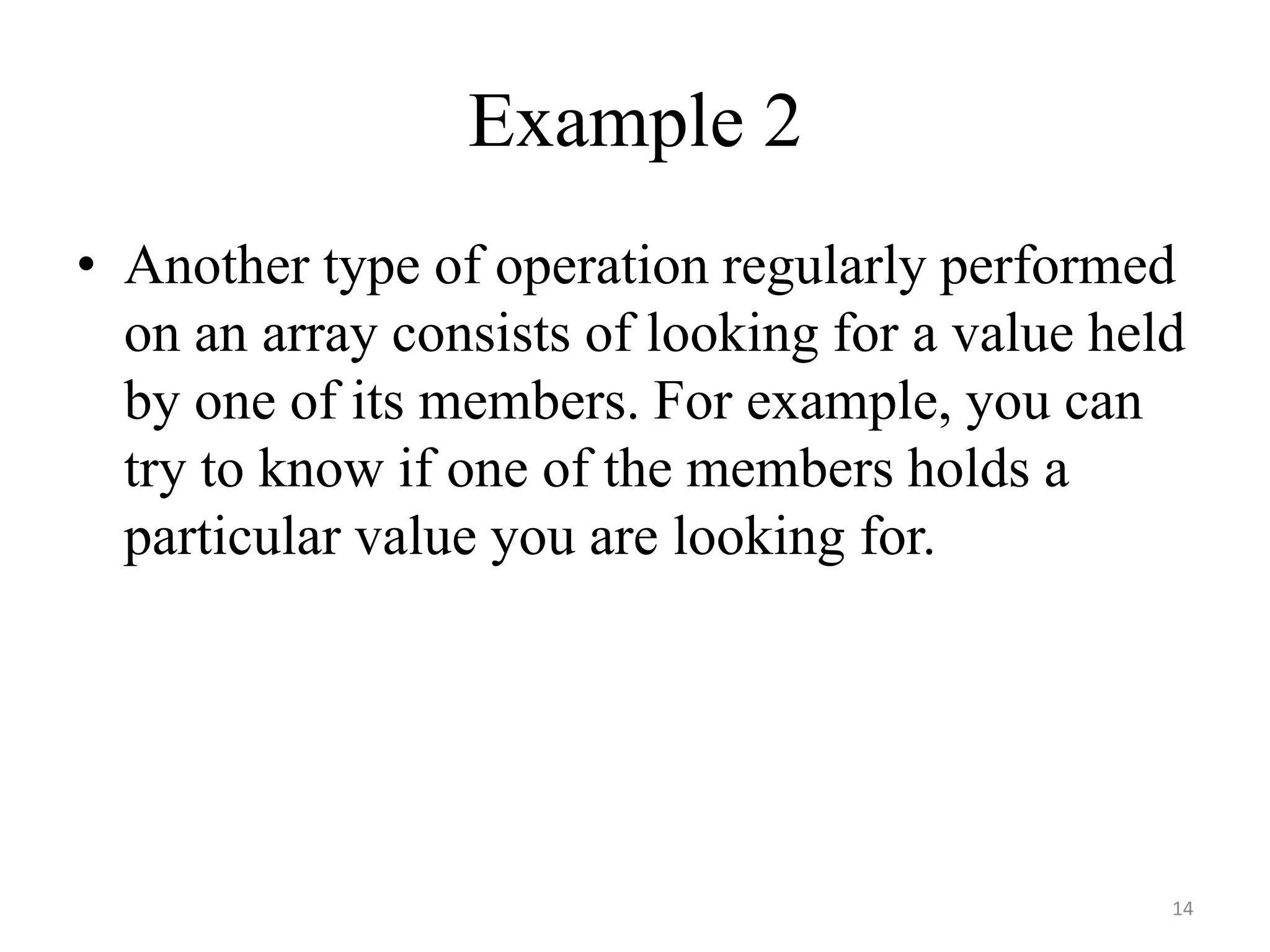
![int main()
{
int numbers[] = {8, 25, 36, 44, 52, 60, 75, 89};
int f, i, m = 8;
cout << "Enter a number to search: ";
cin >> f;
for (i = 0; (i < m) && (numbers[i] != f); i++)
continue;
if (i == m) cout << f << " is not in the list n";
else cout << f << " is the " << i + 1
<< "th element in the list n";
return 0;
}
15](https://image.slidesharecdn.com/05arrays-241020111439-f53002de/75/05_Arrays-C-plus-Programming-language22-pdf-15-2048.jpg)
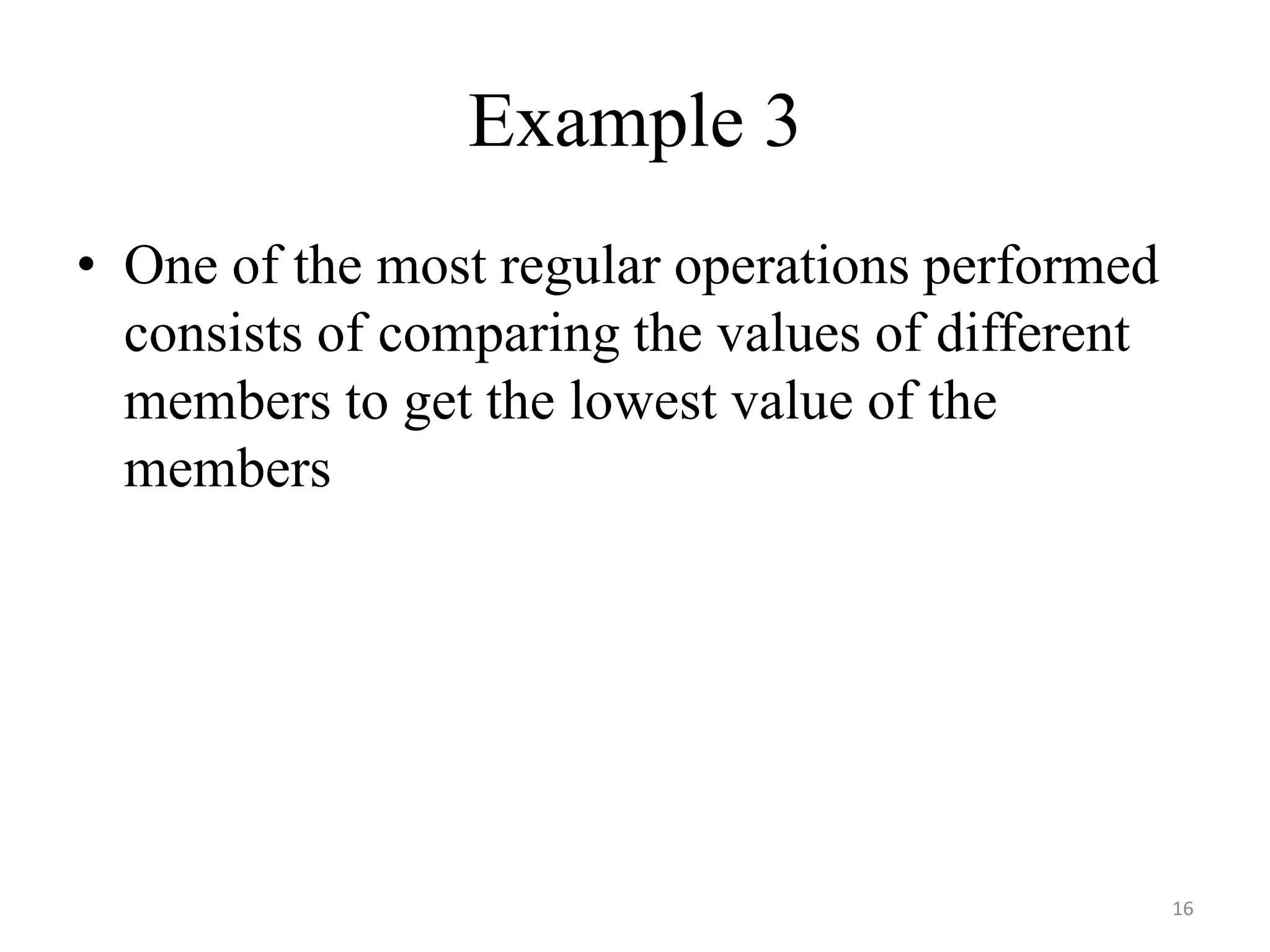
![int main()
{
int numbers[] = {81, 25, 36, 44, 5, 60, 75, 89};
int min = numbers[0];
for (int i = 1; i < 8; ++i)
if (numbers[i] < min) min = numbers[i];
cout << “Minimum = " << min << endl;
return 0;
}
17](https://image.slidesharecdn.com/05arrays-241020111439-f53002de/75/05_Arrays-C-plus-Programming-language22-pdf-17-2048.jpg)
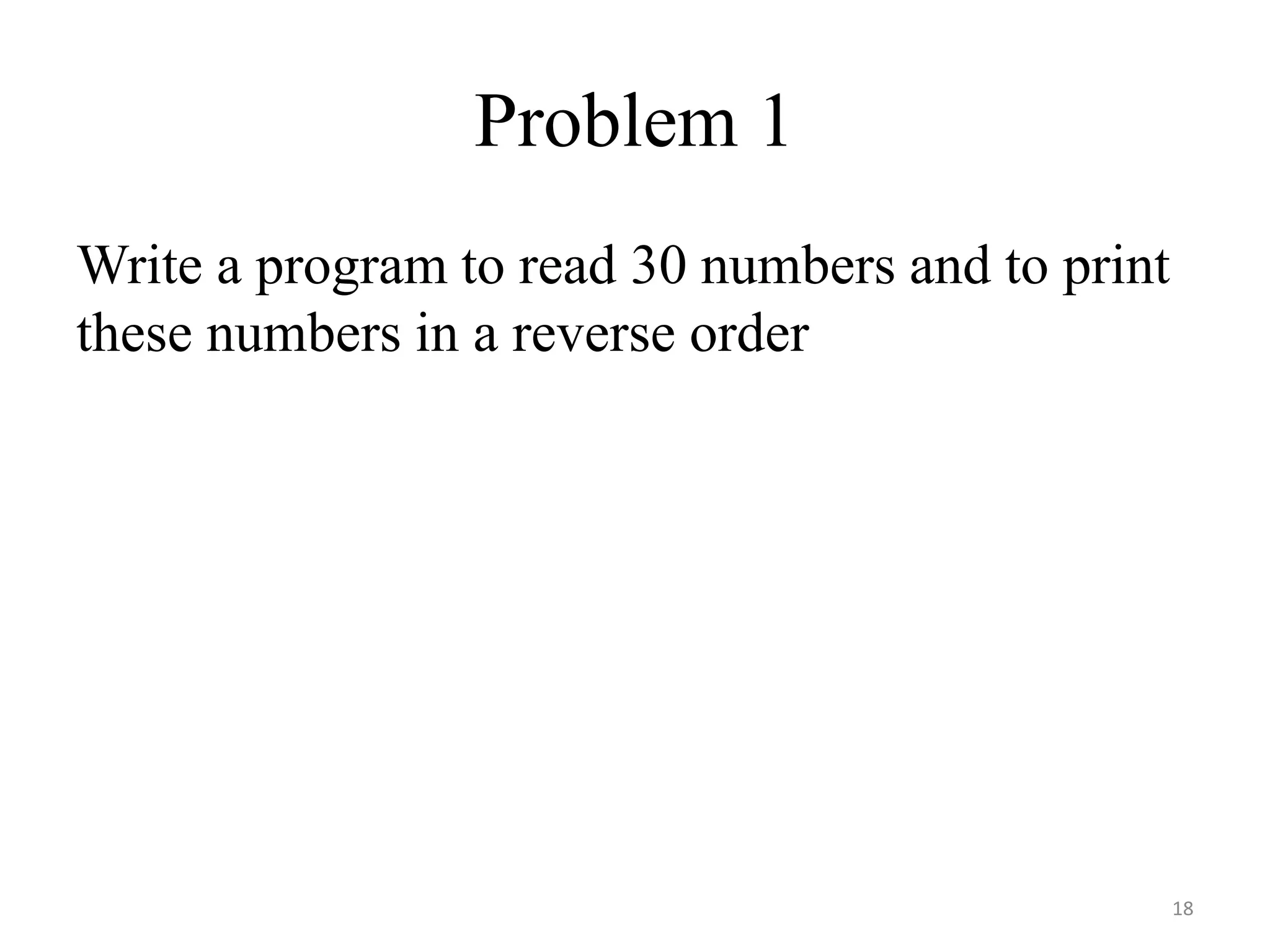
![int main(void)
{
int a[30] , k ;
for(k = 0 ; k <= 29 ; k++)
{
cout << "Enter an integer nuumber: ";
cin >> a[k] ;
}
cout << "n The numbers in reverse order: " ;
for(k = 29 ; k >= 0 ; k--) cout << a[k] << "t";
return 0;
}
19](https://image.slidesharecdn.com/05arrays-241020111439-f53002de/75/05_Arrays-C-plus-Programming-language22-pdf-19-2048.jpg)
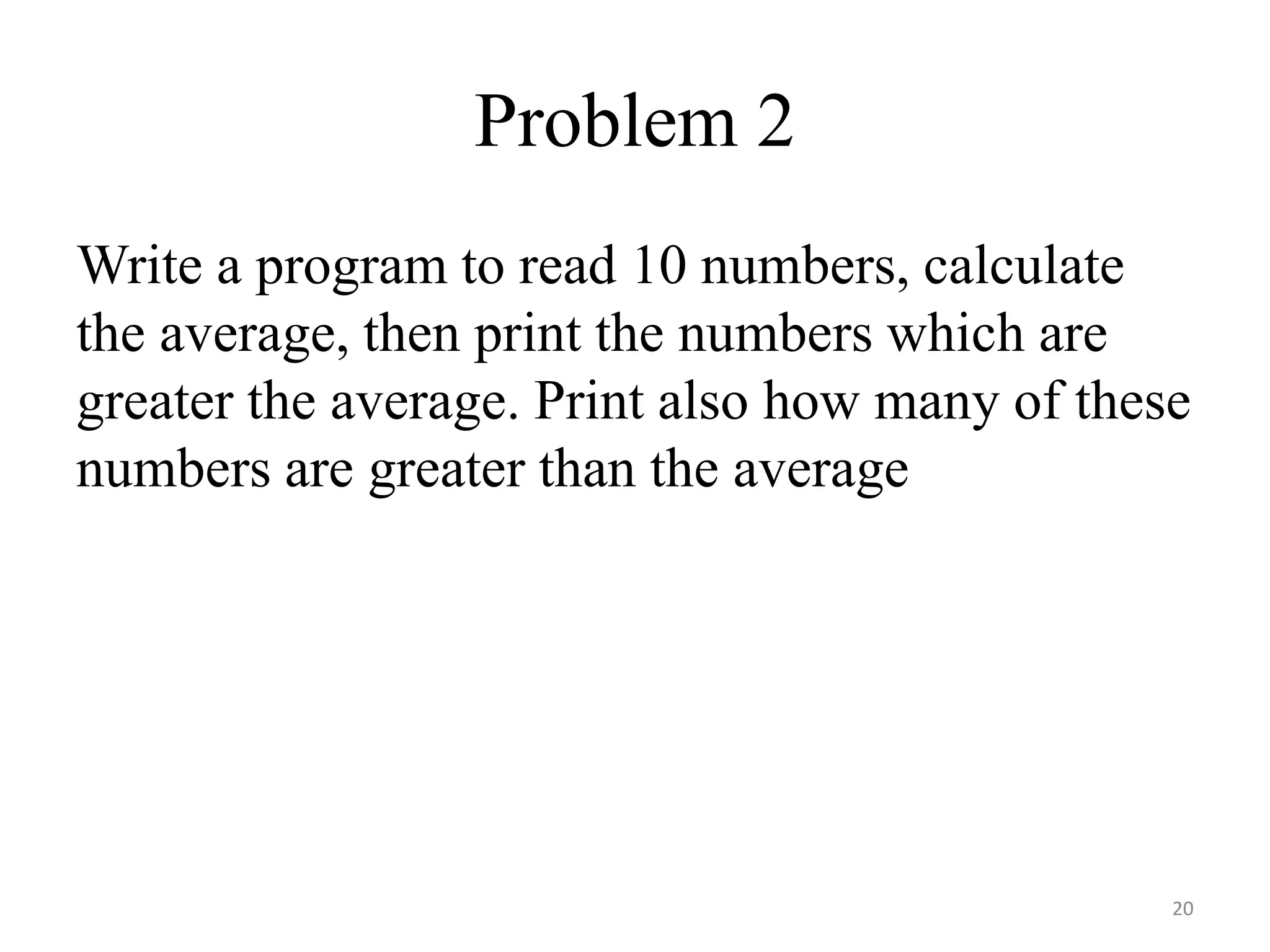
![void main(void)
{
int k , a[10] , sum , counter ;
float aver ;
sum = 0 ;
cout << "Please enter 10 integer numbers: " ;
for(k = 0 ; k <= 9 ; k++)
{
cin >> a[k] ;
sum = sum + a[k] ;
}
aver = sum / 10.0 ;
cout << "Average = " << aver << "n";
21](https://image.slidesharecdn.com/05arrays-241020111439-f53002de/75/05_Arrays-C-plus-Programming-language22-pdf-21-2048.jpg)
![cout << "Numbers greater than average are: ";
counter = 0 ;
for(k = 0 ; k <= 9 ; k++)
if(a[k] > aver)
{
counter++ ;
cout << a[k] << "t" ;
}
cout << "n We have " << counter <<
"numbers greater than average n";
}
22](https://image.slidesharecdn.com/05arrays-241020111439-f53002de/75/05_Arrays-C-plus-Programming-language22-pdf-22-2048.jpg)
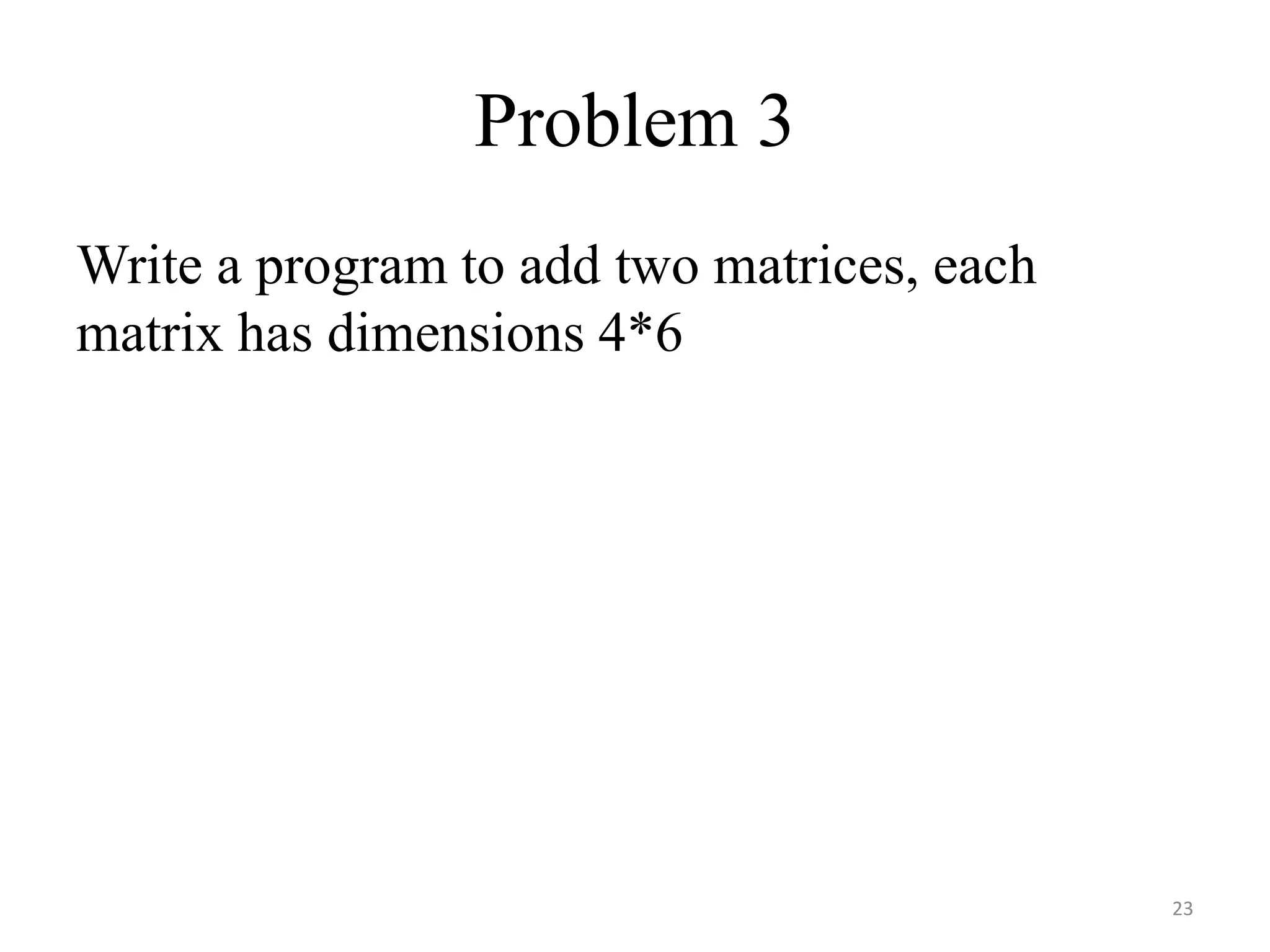
![int main(void)
{
int a[4][6] , b[4][6] , sum[4][6] , r , c ;
cout << "Enter first matrix: n";
for(r = 0 ; r <= 3 ; r++)
for(c = 0 ; c <= 5 ; c++)
{
cout << "a["<<r<<"]["<<c<<"]=" ;
cin >> a[r][c] ;
}
24](https://image.slidesharecdn.com/05arrays-241020111439-f53002de/75/05_Arrays-C-plus-Programming-language22-pdf-24-2048.jpg)
![cout << "Enter second matrix: n";
for(r = 0 ; r <= 3 ; r++)
for(c = 0 ; c <= 5 ; c++)
{
cout << "b["<<r<<"]["<<c<<"]=" ;
cin >> b[r][c] ;
}
25](https://image.slidesharecdn.com/05arrays-241020111439-f53002de/75/05_Arrays-C-plus-Programming-language22-pdf-25-2048.jpg)
![cout << "The result n";
for(r = 0 ; r <= 3 ; r++)
{
for(c = 0 ; c <= 5 ; c++)
{
sum[r][c] = a[r][c] + b[r][c] ;
cout << sum[r][c] << "t";
}
cout << "n";
}
return 0;
}
26](https://image.slidesharecdn.com/05arrays-241020111439-f53002de/75/05_Arrays-C-plus-Programming-language22-pdf-26-2048.jpg)
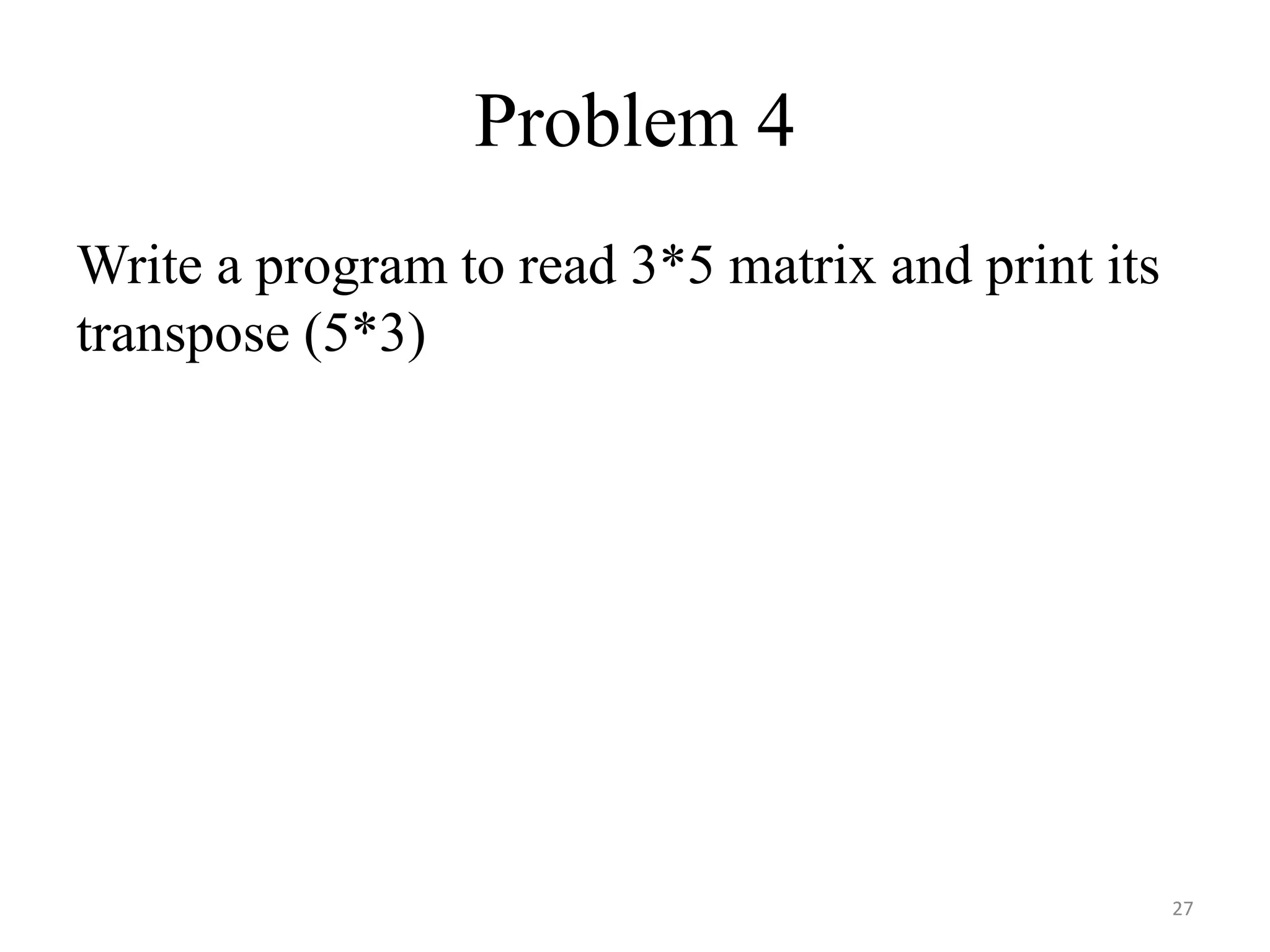
![void main(void)
{
int m[3][5] , r , c ;
cout << "Please enter 3*5 matrix: n";
for(r = 0 ; r <= 2 ; r++)
for(c = 0 ; c <= 4 ; c++) cin >> m[r][c] ;
cout << "The transpose matrix is: ";
for(c = 0 ; c <= 4 ; c++)
{
for(r = 0 ; r <= 2 ; r++) cout << m[r][c] << "t";
cout << "n";
}
} 28](https://image.slidesharecdn.com/05arrays-241020111439-f53002de/75/05_Arrays-C-plus-Programming-language22-pdf-28-2048.jpg)
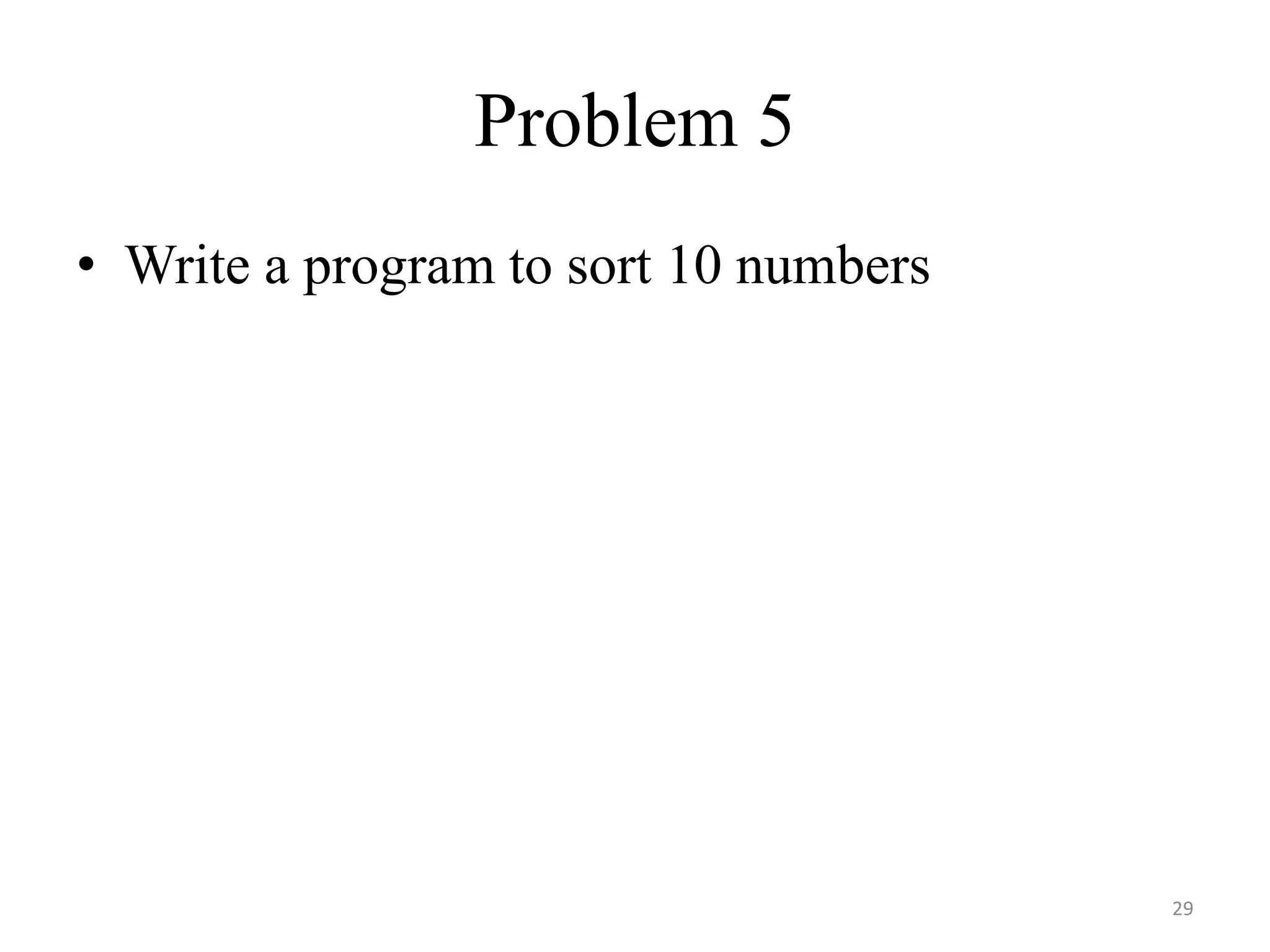
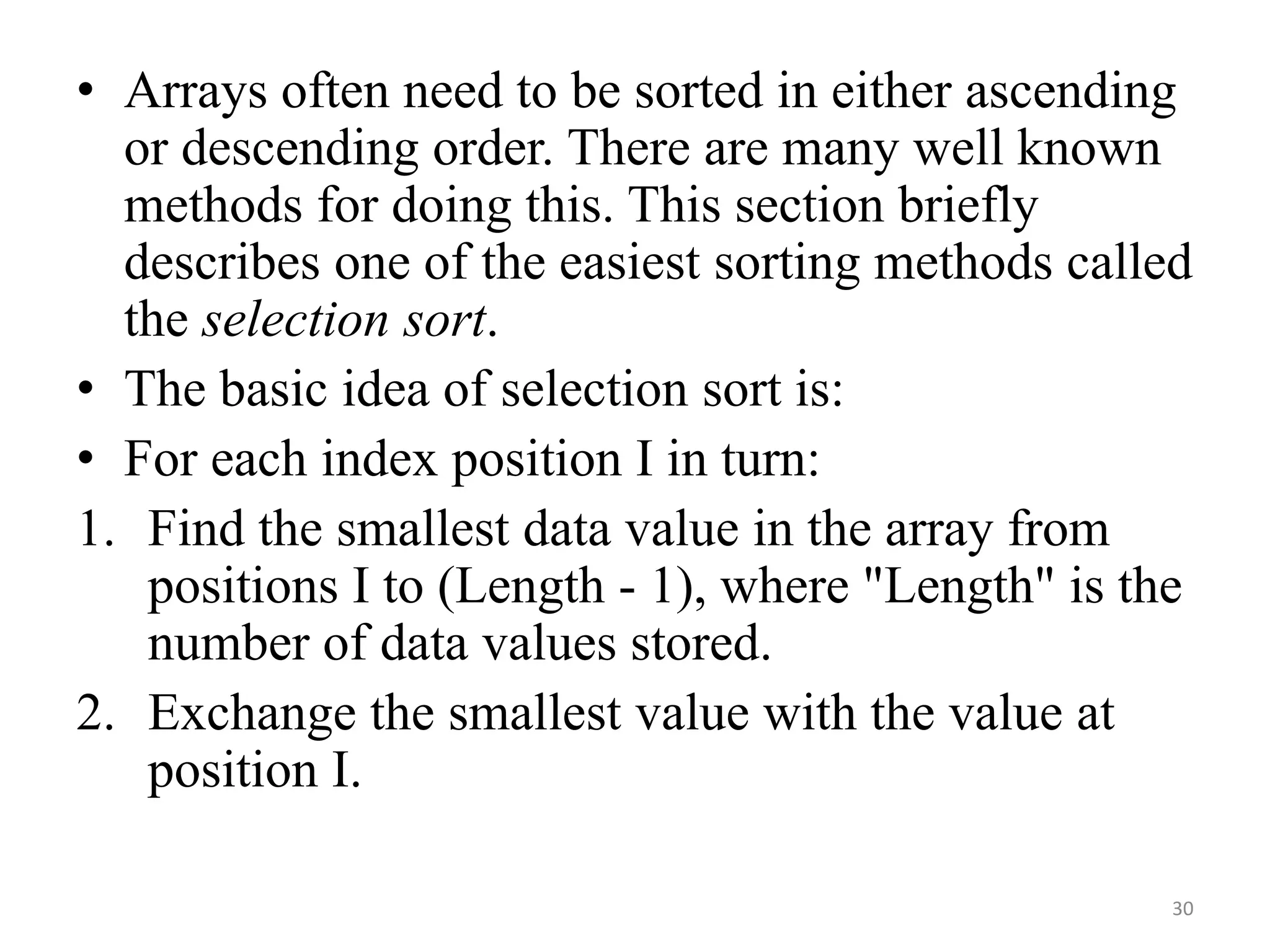
![void main(void)
{
int y[10] , min , minloc , r , k , temp ;
cout << "Please enter 10 numbers: ";
for(r = 0 ; r <= 9 ; r++) cin >> y[r] ;
for(k = 0 ; k <= 8 ; k++) {
min = y[k] ; minloc = k ;
for(r = k+1 ; r <= 9 ; r++)
if(min > y[r] ) { min = y[r] ; minloc = r ; }
temp = y[k]; y[k] = y[minloc]; y[minloc] = temp;
}
for(r = 0 ; r <= 9 ; r++) cout << y[r] << "t" ;
}
31](https://image.slidesharecdn.com/05arrays-241020111439-f53002de/75/05_Arrays-C-plus-Programming-language22-pdf-31-2048.jpg)
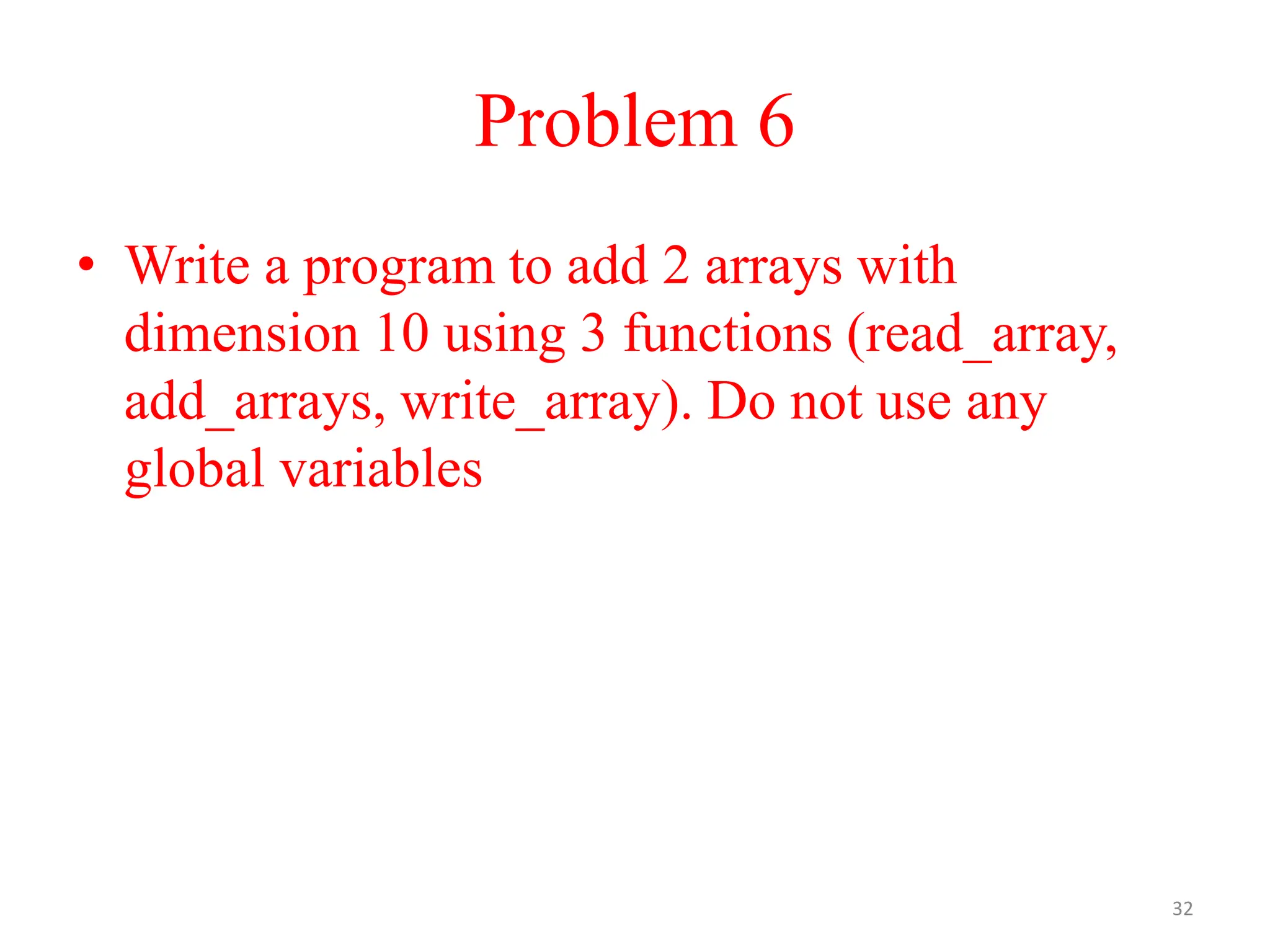
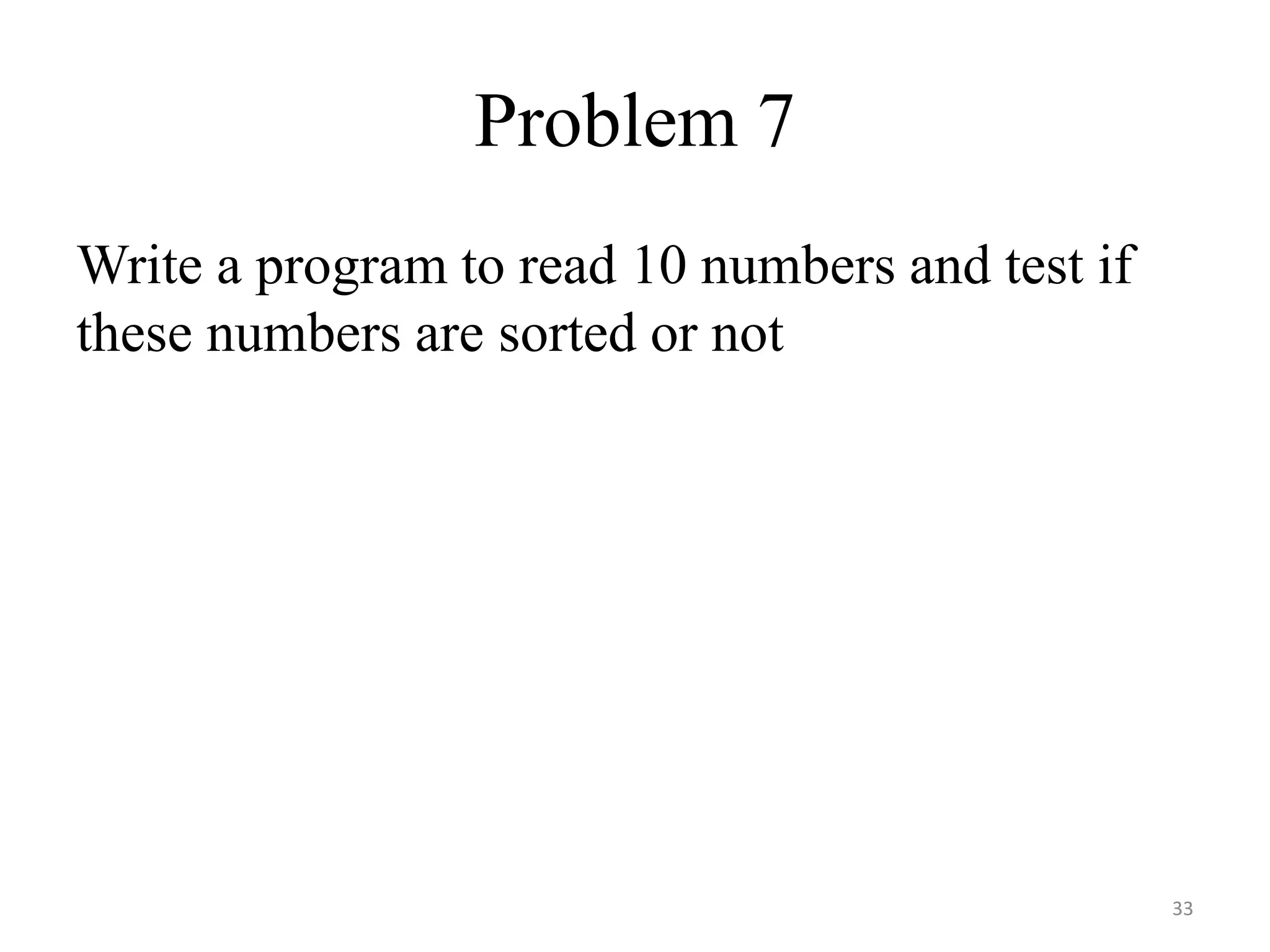
![int main()
{
int num[10] , res , k , count1 = 0 , count2 = 0 , length = 10;
for(k = 0 ; k < =length-1 ; k++)
{
cout << "Enter term number " << k << " : ";
cin >> num[k] ;
}
for(k = 0 ; k <= length-2 ; k++)
{
if(pt[k] > pt[k+1]) counter1++ ;
if(pt[k] < pt[k+1]) counter2++ ;
}
34](https://image.slidesharecdn.com/05arrays-241020111439-f53002de/75/05_Arrays-C-plus-Programming-language22-pdf-34-2048.jpg)
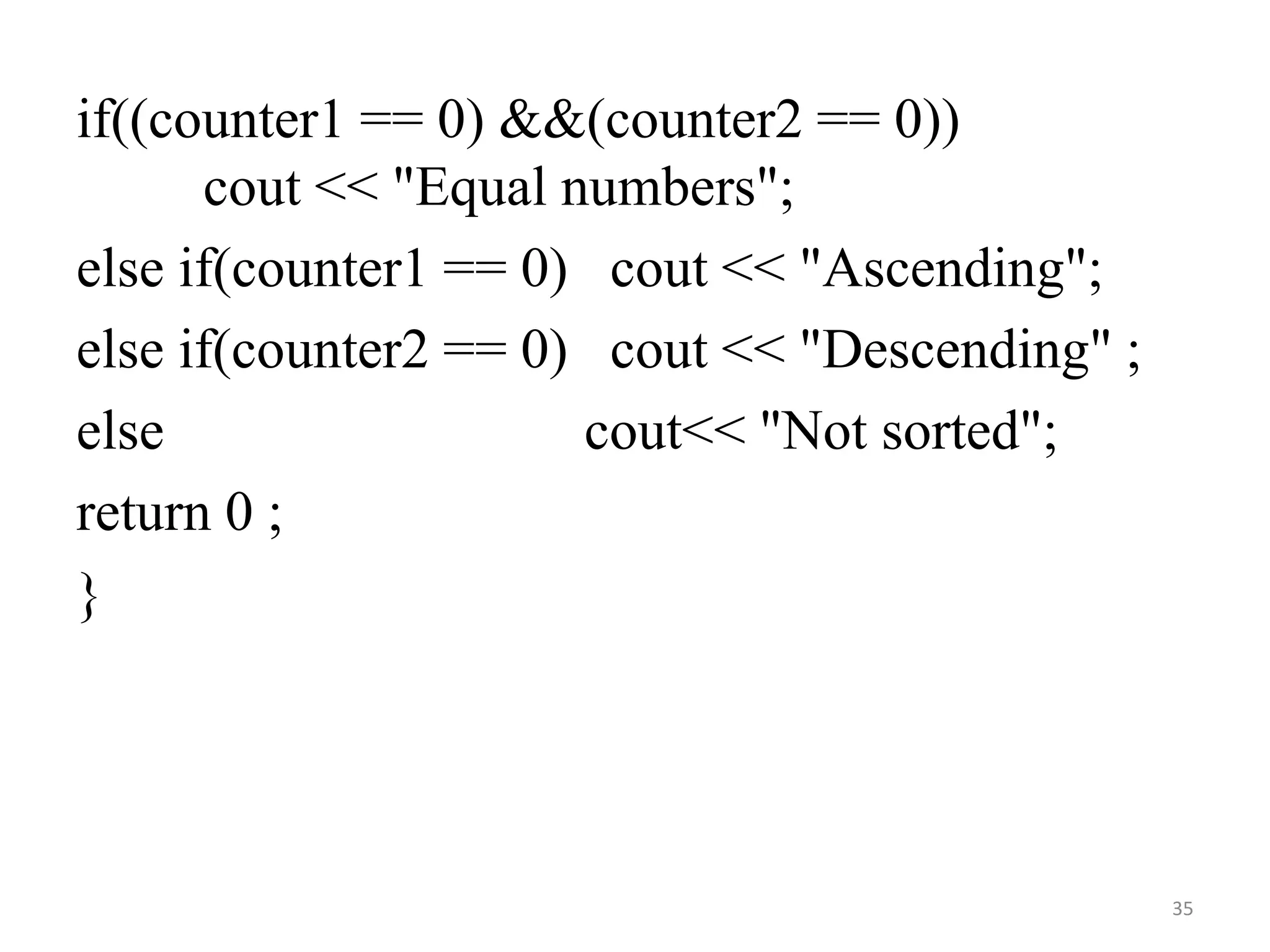
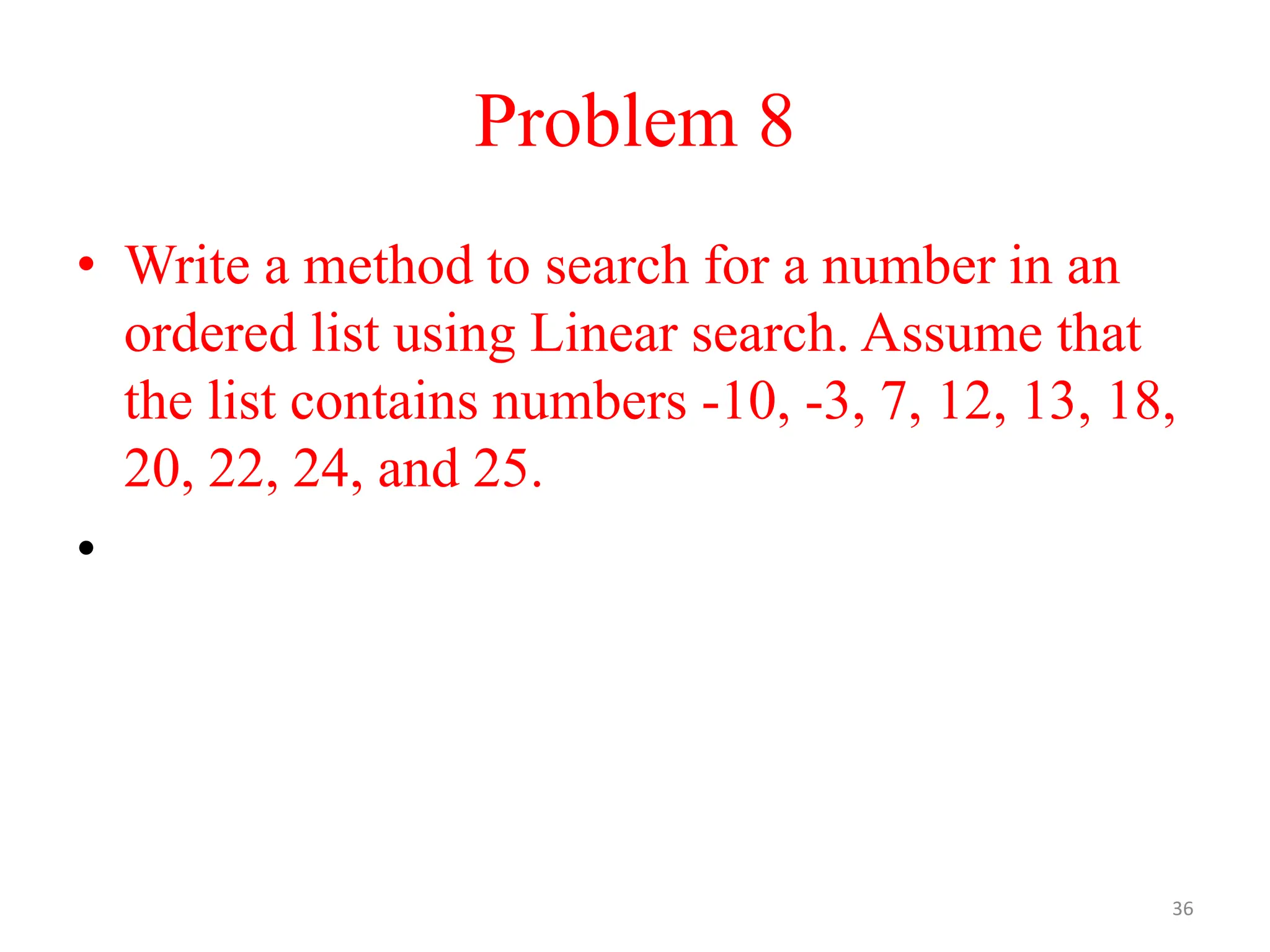
![void main(void)
{
int key , res , j ;
int y[ ] = {-10, -3, 7, 12, 13, 18, 20, 22, 24, 25 };
cout << "Please enter the key number: ";
cin >> key ;
for(j = 0 ; j <= 9 ; j++)
if(y[j] == key) break ;
if(j == 10) cout << "Key does not exist n" ;
else cout << " Key exists at " << j <<"n";
}
37](https://image.slidesharecdn.com/05arrays-241020111439-f53002de/75/05_Arrays-C-plus-Programming-language22-pdf-37-2048.jpg)
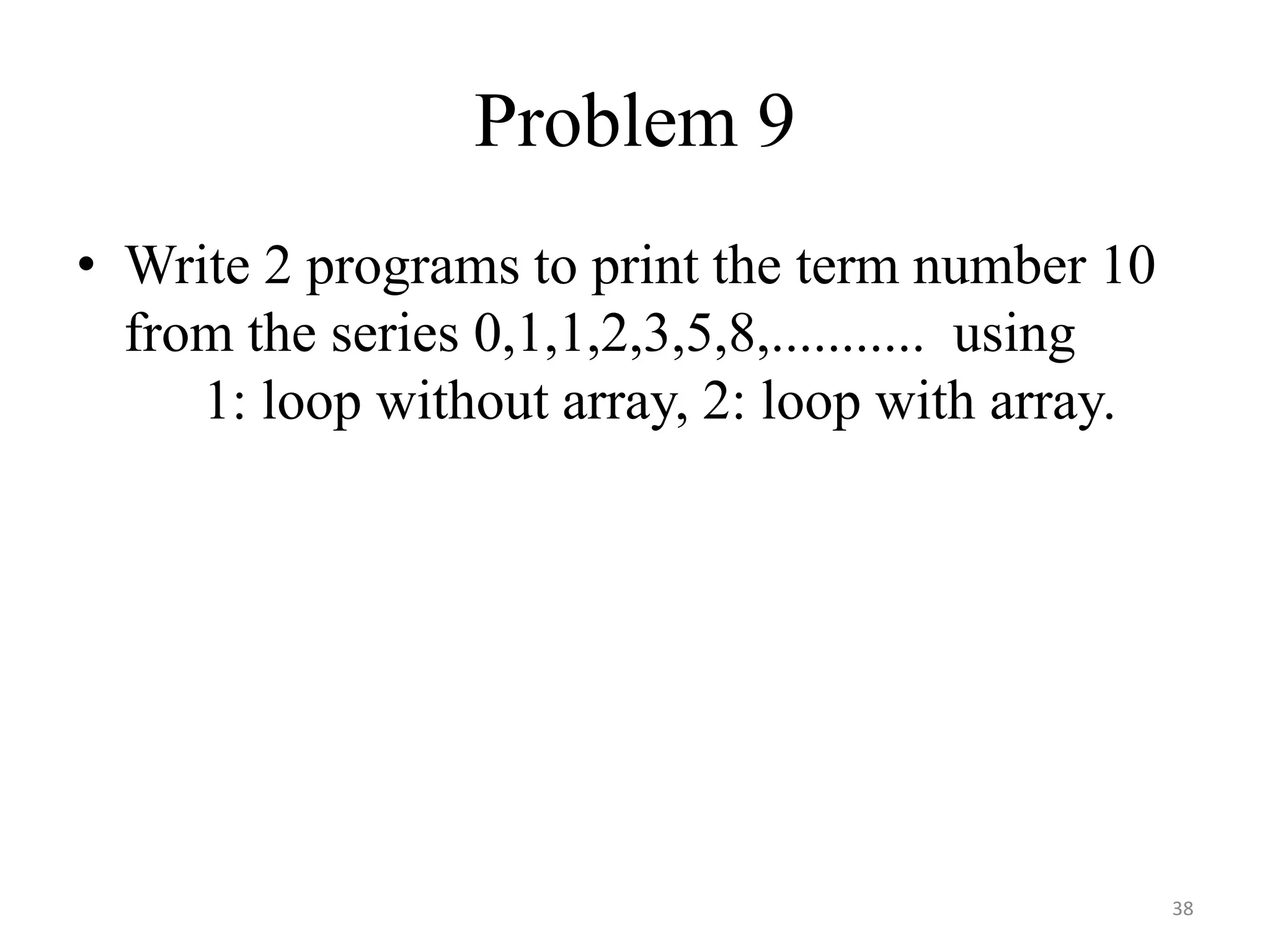
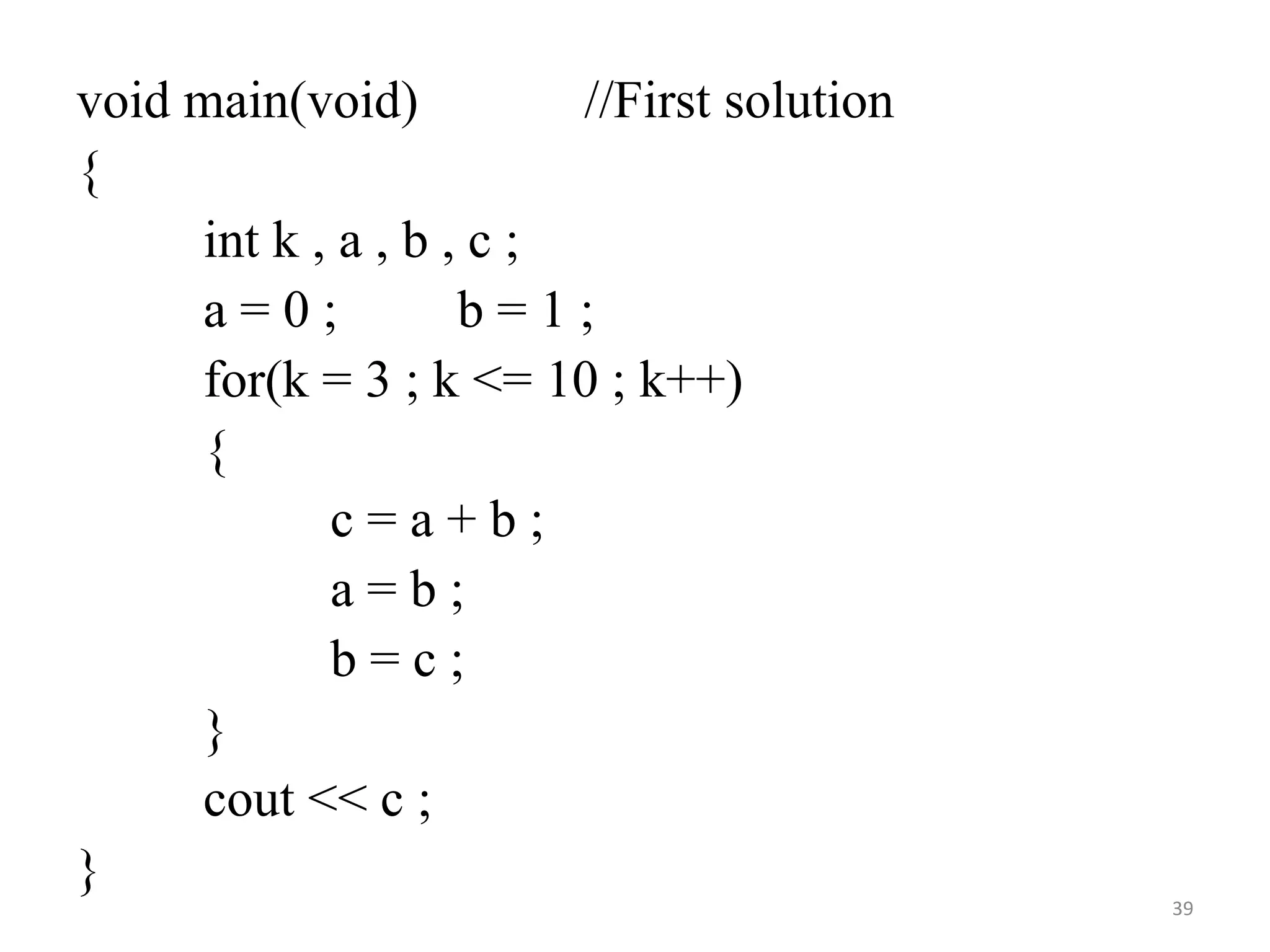
![void main(void) // Second solution
{
int a[10] , k ;
a[0] = 0 ;
a[1] = 1 ;
for(k = 2 ; k <= 9 ; k++)
a[k] = a[k-1] + a[k-2] ;
cout << a[9] ;
}
40](https://image.slidesharecdn.com/05arrays-241020111439-f53002de/75/05_Arrays-C-plus-Programming-language22-pdf-40-2048.jpg)
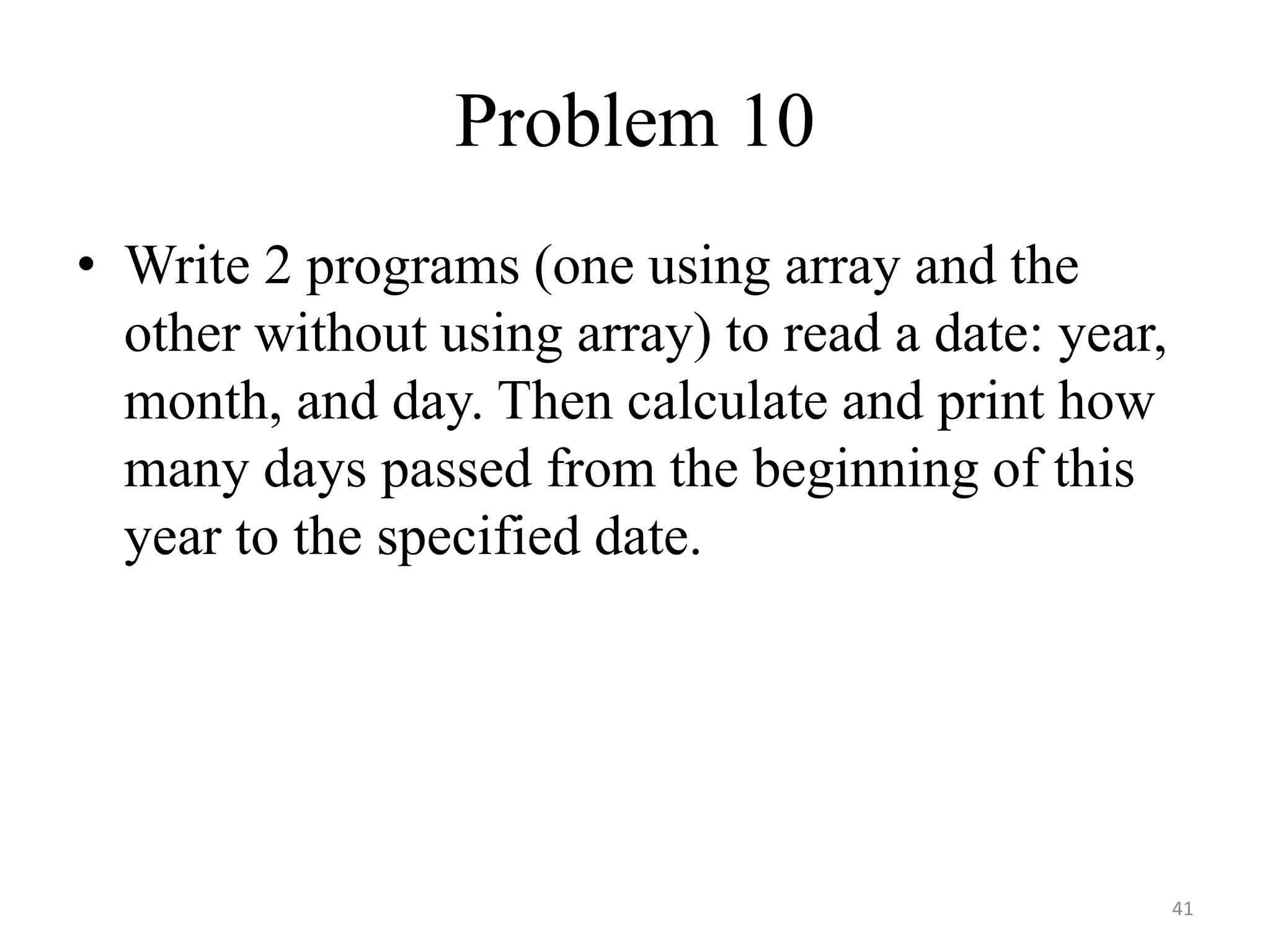
![void main()
{
int mon[] = {31,28,31,30,31,30,31,31,30,31,30,31};
int d , m , y , days ;
cout << "Enter day month year: ";
cin >> d >> m >> y ;
days = 0 ;
for(int k = 0 ; k < m-1 ; k++)
days = days + mon[k] ;
if((m > 2)&&(y%4 == 0)) days++;
days = days + d ;
cout << "n Number of days = %d n" << days;
}
42](https://image.slidesharecdn.com/05arrays-241020111439-f53002de/75/05_Arrays-C-plus-Programming-language22-pdf-42-2048.jpg)
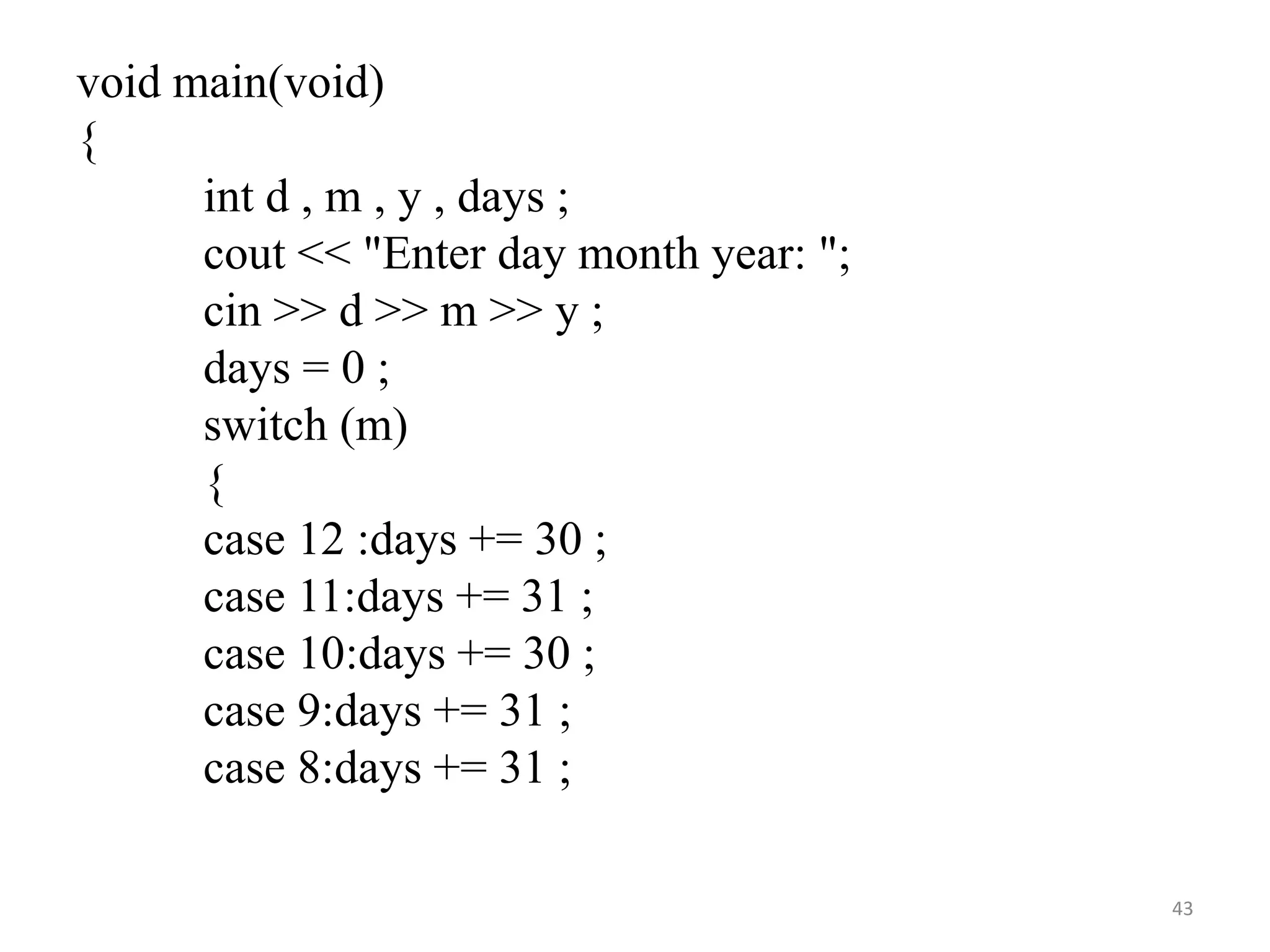
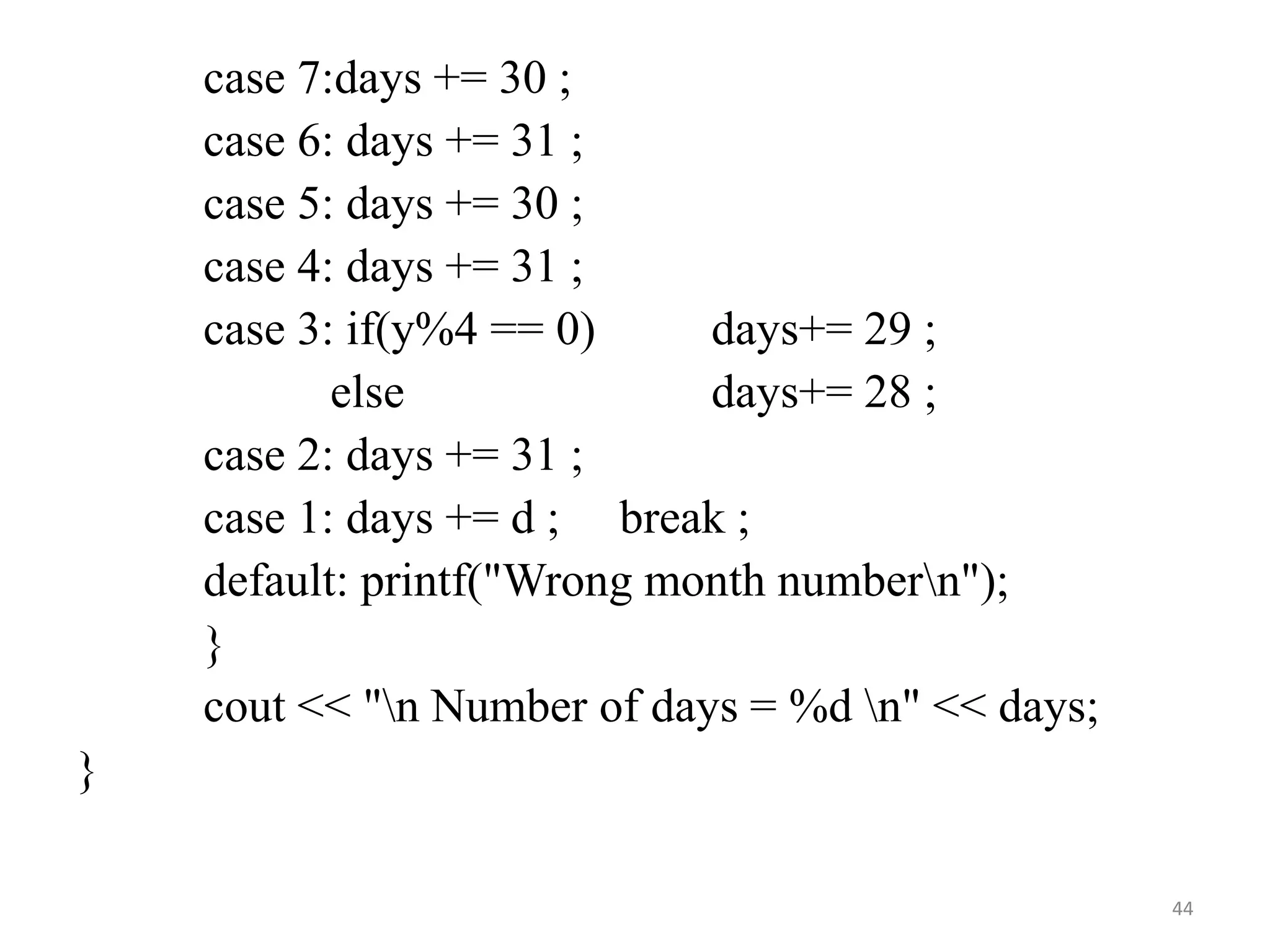
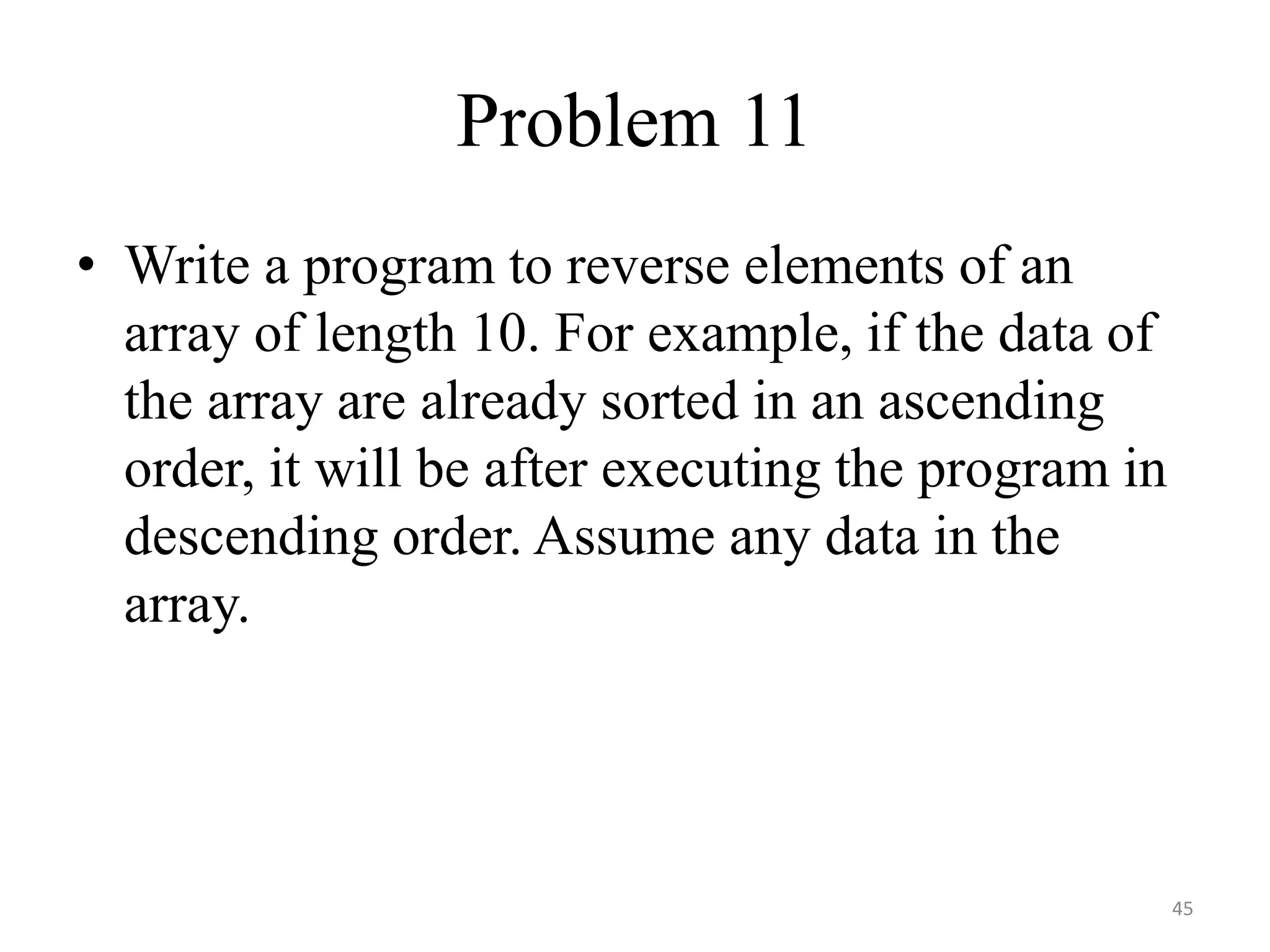
![void main()
{
int x[ ] = { 1, 3, 7, 10, 12, 16, 19, 25, 29, 30 };
int y[10] , k ;
for(k = 0 ; k <= 9 ; k++) y[k] = x[9 - k] ;
for(k = 0 ; k <= 9 ; k++)
{
x[k] = y[k] ;
cout << x[k] << “t”;
}
}
46](https://image.slidesharecdn.com/05arrays-241020111439-f53002de/75/05_Arrays-C-plus-Programming-language22-pdf-46-2048.jpg)
